Garden City Planning: Principles and Elements
VerifiedAdded on 2023/06/11
|23
|4013
|100
AI Summary
This article discusses the principles and elements of garden city planning, including zoning, road systems, transport facilities, public buildings, and suburbs. It explores how these principles were applied in the design of Port Sunlight and Canberra suburbs. The article also highlights the legacy of the garden city movement.
Contribute Materials
Your contribution can guide someone’s learning journey. Share your
documents today.
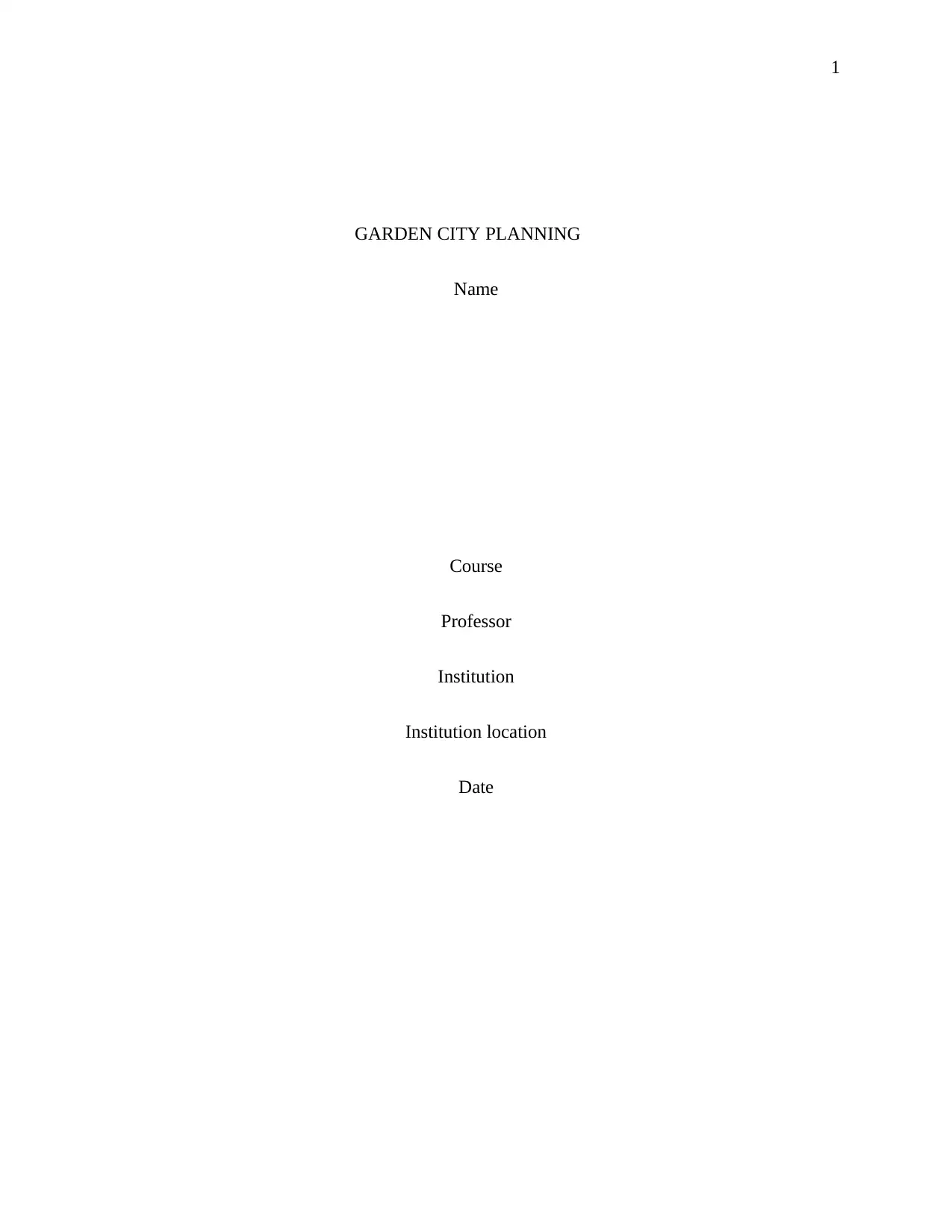
1
GARDEN CITY PLANNING
Name
Course
Professor
Institution
Institution location
Date
GARDEN CITY PLANNING
Name
Course
Professor
Institution
Institution location
Date
Secure Best Marks with AI Grader
Need help grading? Try our AI Grader for instant feedback on your assignments.
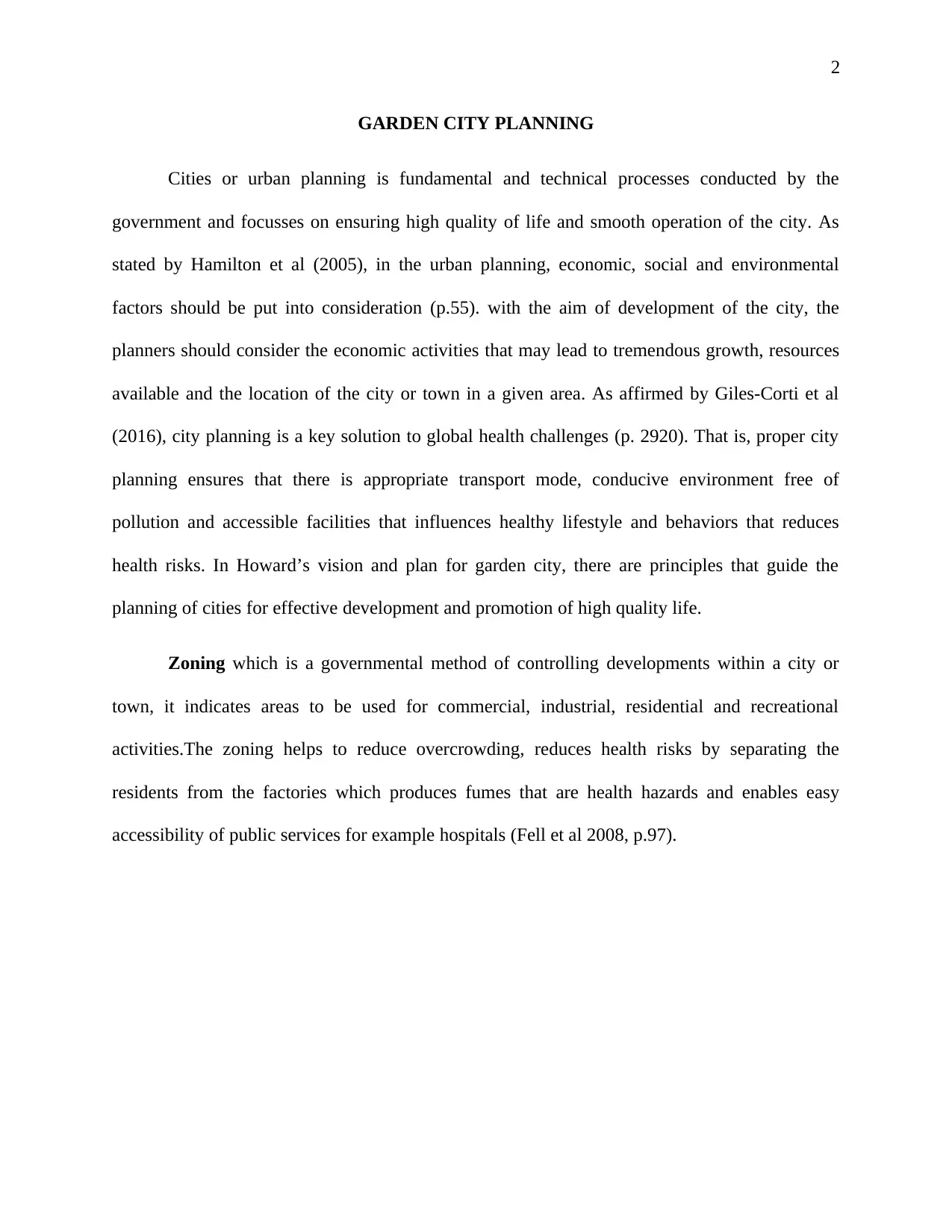
2
GARDEN CITY PLANNING
Cities or urban planning is fundamental and technical processes conducted by the
government and focusses on ensuring high quality of life and smooth operation of the city. As
stated by Hamilton et al (2005), in the urban planning, economic, social and environmental
factors should be put into consideration (p.55). with the aim of development of the city, the
planners should consider the economic activities that may lead to tremendous growth, resources
available and the location of the city or town in a given area. As affirmed by Giles-Corti et al
(2016), city planning is a key solution to global health challenges (p. 2920). That is, proper city
planning ensures that there is appropriate transport mode, conducive environment free of
pollution and accessible facilities that influences healthy lifestyle and behaviors that reduces
health risks. In Howard’s vision and plan for garden city, there are principles that guide the
planning of cities for effective development and promotion of high quality life.
Zoning which is a governmental method of controlling developments within a city or
town, it indicates areas to be used for commercial, industrial, residential and recreational
activities.The zoning helps to reduce overcrowding, reduces health risks by separating the
residents from the factories which produces fumes that are health hazards and enables easy
accessibility of public services for example hospitals (Fell et al 2008, p.97).
GARDEN CITY PLANNING
Cities or urban planning is fundamental and technical processes conducted by the
government and focusses on ensuring high quality of life and smooth operation of the city. As
stated by Hamilton et al (2005), in the urban planning, economic, social and environmental
factors should be put into consideration (p.55). with the aim of development of the city, the
planners should consider the economic activities that may lead to tremendous growth, resources
available and the location of the city or town in a given area. As affirmed by Giles-Corti et al
(2016), city planning is a key solution to global health challenges (p. 2920). That is, proper city
planning ensures that there is appropriate transport mode, conducive environment free of
pollution and accessible facilities that influences healthy lifestyle and behaviors that reduces
health risks. In Howard’s vision and plan for garden city, there are principles that guide the
planning of cities for effective development and promotion of high quality life.
Zoning which is a governmental method of controlling developments within a city or
town, it indicates areas to be used for commercial, industrial, residential and recreational
activities.The zoning helps to reduce overcrowding, reduces health risks by separating the
residents from the factories which produces fumes that are health hazards and enables easy
accessibility of public services for example hospitals (Fell et al 2008, p.97).
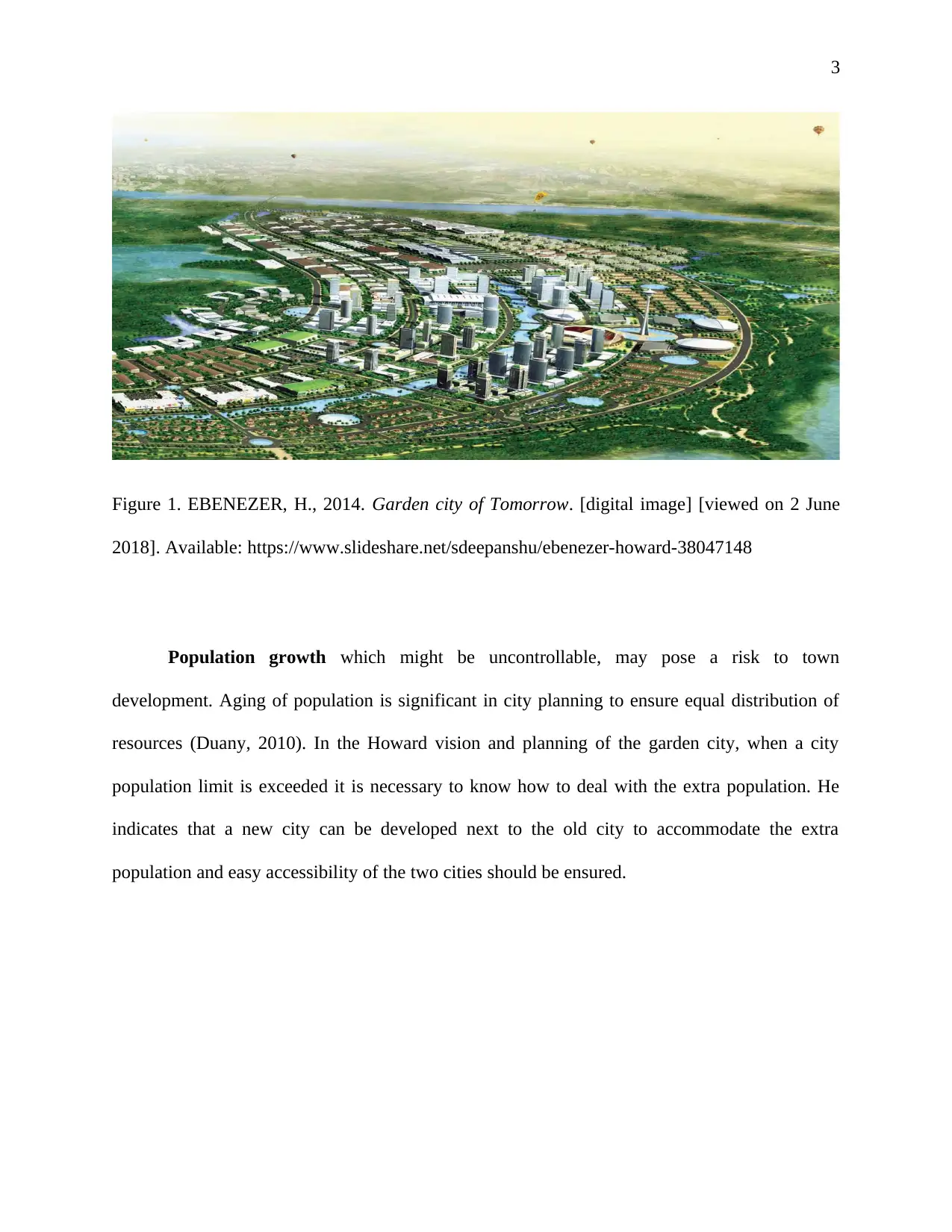
3
Figure 1. EBENEZER, H., 2014. Garden city of Tomorrow. [digital image] [viewed on 2 June
2018]. Available: https://www.slideshare.net/sdeepanshu/ebenezer-howard-38047148
Population growth which might be uncontrollable, may pose a risk to town
development. Aging of population is significant in city planning to ensure equal distribution of
resources (Duany, 2010). In the Howard vision and planning of the garden city, when a city
population limit is exceeded it is necessary to know how to deal with the extra population. He
indicates that a new city can be developed next to the old city to accommodate the extra
population and easy accessibility of the two cities should be ensured.
Figure 1. EBENEZER, H., 2014. Garden city of Tomorrow. [digital image] [viewed on 2 June
2018]. Available: https://www.slideshare.net/sdeepanshu/ebenezer-howard-38047148
Population growth which might be uncontrollable, may pose a risk to town
development. Aging of population is significant in city planning to ensure equal distribution of
resources (Duany, 2010). In the Howard vision and planning of the garden city, when a city
population limit is exceeded it is necessary to know how to deal with the extra population. He
indicates that a new city can be developed next to the old city to accommodate the extra
population and easy accessibility of the two cities should be ensured.
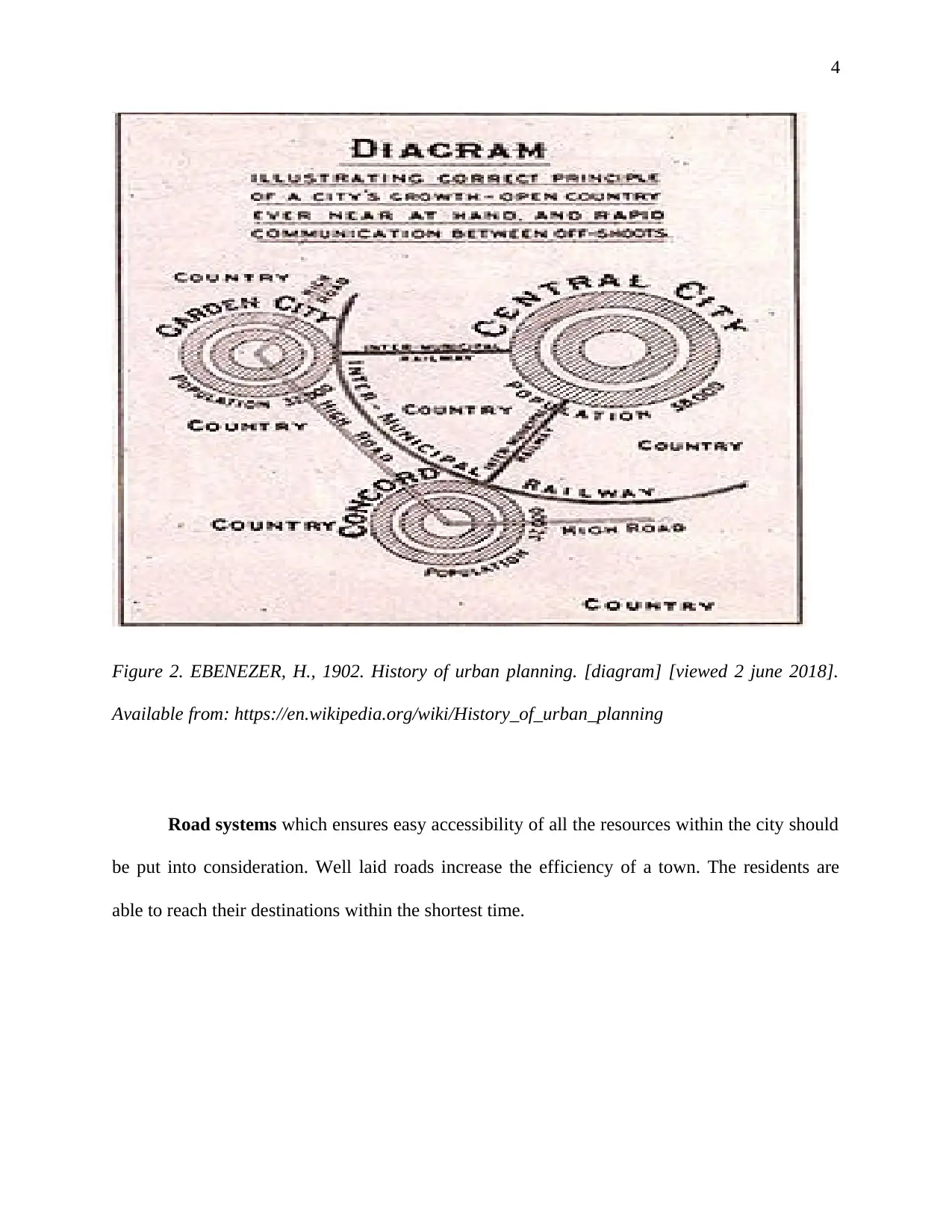
4
Figure 2. EBENEZER, H., 1902. History of urban planning. [diagram] [viewed 2 june 2018].
Available from: https://en.wikipedia.org/wiki/History_of_urban_planning
Road systems which ensures easy accessibility of all the resources within the city should
be put into consideration. Well laid roads increase the efficiency of a town. The residents are
able to reach their destinations within the shortest time.
Figure 2. EBENEZER, H., 1902. History of urban planning. [diagram] [viewed 2 june 2018].
Available from: https://en.wikipedia.org/wiki/History_of_urban_planning
Road systems which ensures easy accessibility of all the resources within the city should
be put into consideration. Well laid roads increase the efficiency of a town. The residents are
able to reach their destinations within the shortest time.
Secure Best Marks with AI Grader
Need help grading? Try our AI Grader for instant feedback on your assignments.
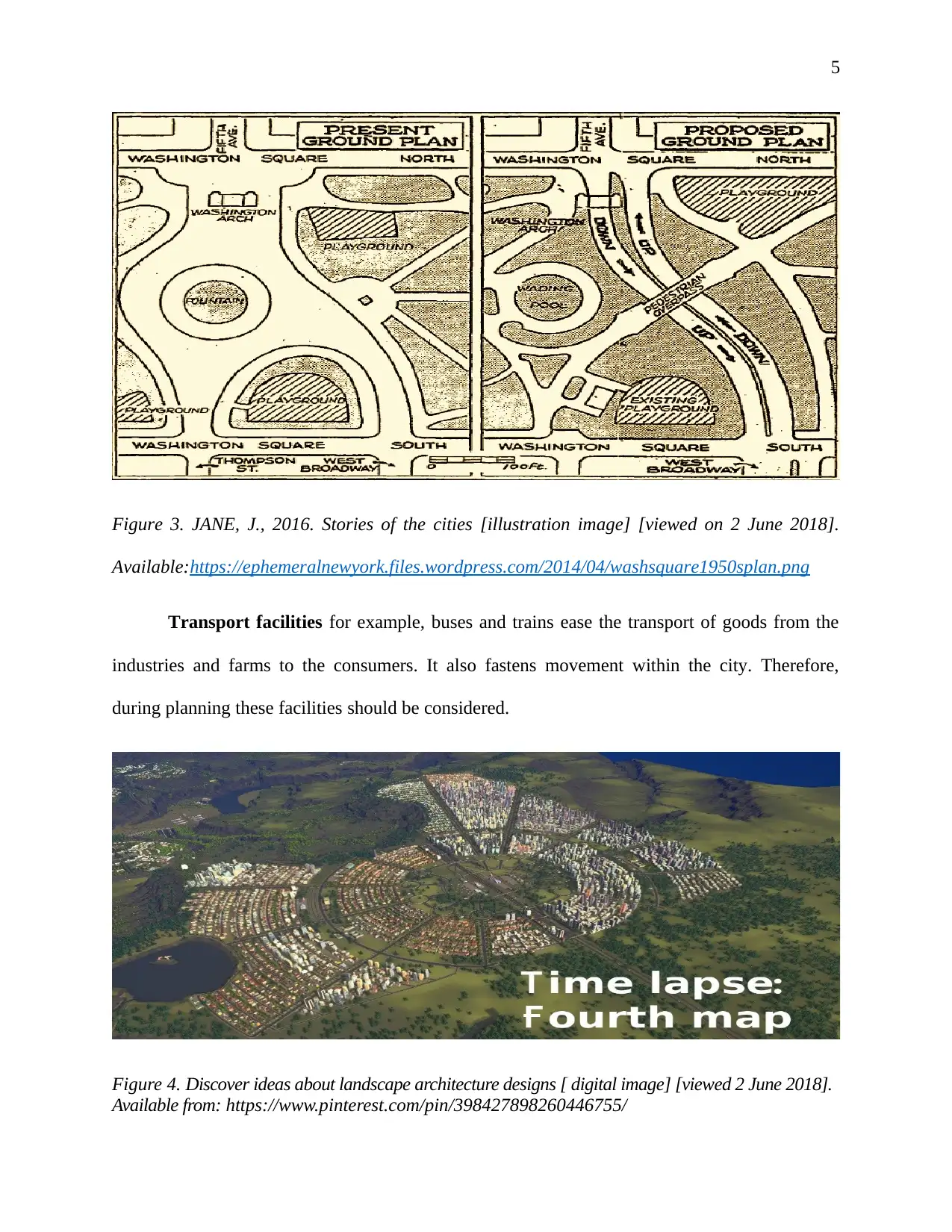
5
Figure 3. JANE, J., 2016. Stories of the cities [illustration image] [viewed on 2 June 2018].
Available:https://ephemeralnewyork.files.wordpress.com/2014/04/washsquare1950splan.png
Transport facilities for example, buses and trains ease the transport of goods from the
industries and farms to the consumers. It also fastens movement within the city. Therefore,
during planning these facilities should be considered.
Figure 4. Discover ideas about landscape architecture designs [ digital image] [viewed 2 June 2018].
Available from: https://www.pinterest.com/pin/398427898260446755/
Figure 3. JANE, J., 2016. Stories of the cities [illustration image] [viewed on 2 June 2018].
Available:https://ephemeralnewyork.files.wordpress.com/2014/04/washsquare1950splan.png
Transport facilities for example, buses and trains ease the transport of goods from the
industries and farms to the consumers. It also fastens movement within the city. Therefore,
during planning these facilities should be considered.
Figure 4. Discover ideas about landscape architecture designs [ digital image] [viewed 2 June 2018].
Available from: https://www.pinterest.com/pin/398427898260446755/
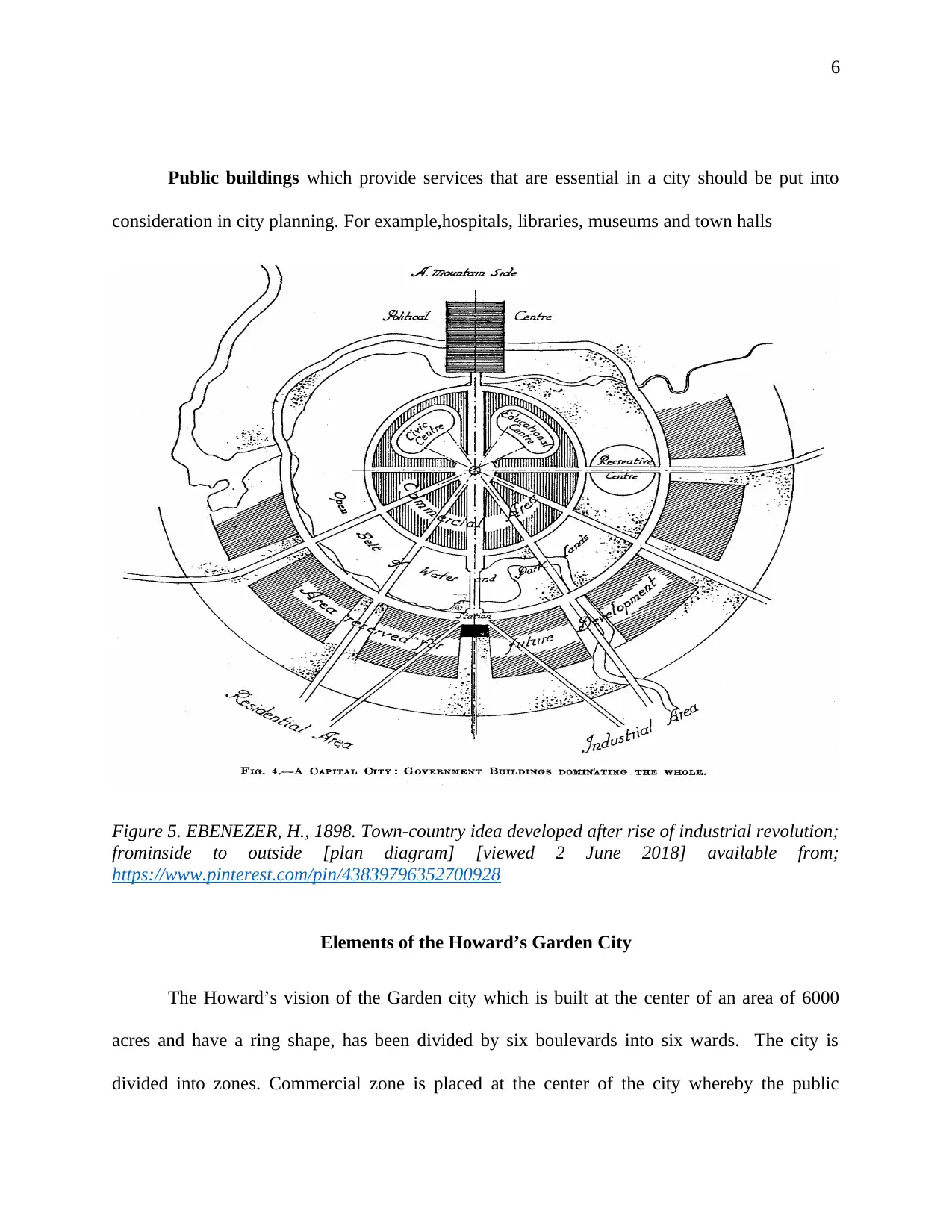
6
Public buildings which provide services that are essential in a city should be put into
consideration in city planning. For example,hospitals, libraries, museums and town halls
Figure 5. EBENEZER, H., 1898. Town-country idea developed after rise of industrial revolution;
frominside to outside [plan diagram] [viewed 2 June 2018] available from;
https://www.pinterest.com/pin/43839796352700928
Elements of the Howard’s Garden City
The Howard’s vision of the Garden city which is built at the center of an area of 6000
acres and have a ring shape, has been divided by six boulevards into six wards. The city is
divided into zones. Commercial zone is placed at the center of the city whereby the public
Public buildings which provide services that are essential in a city should be put into
consideration in city planning. For example,hospitals, libraries, museums and town halls
Figure 5. EBENEZER, H., 1898. Town-country idea developed after rise of industrial revolution;
frominside to outside [plan diagram] [viewed 2 June 2018] available from;
https://www.pinterest.com/pin/43839796352700928
Elements of the Howard’s Garden City
The Howard’s vision of the Garden city which is built at the center of an area of 6000
acres and have a ring shape, has been divided by six boulevards into six wards. The city is
divided into zones. Commercial zone is placed at the center of the city whereby the public
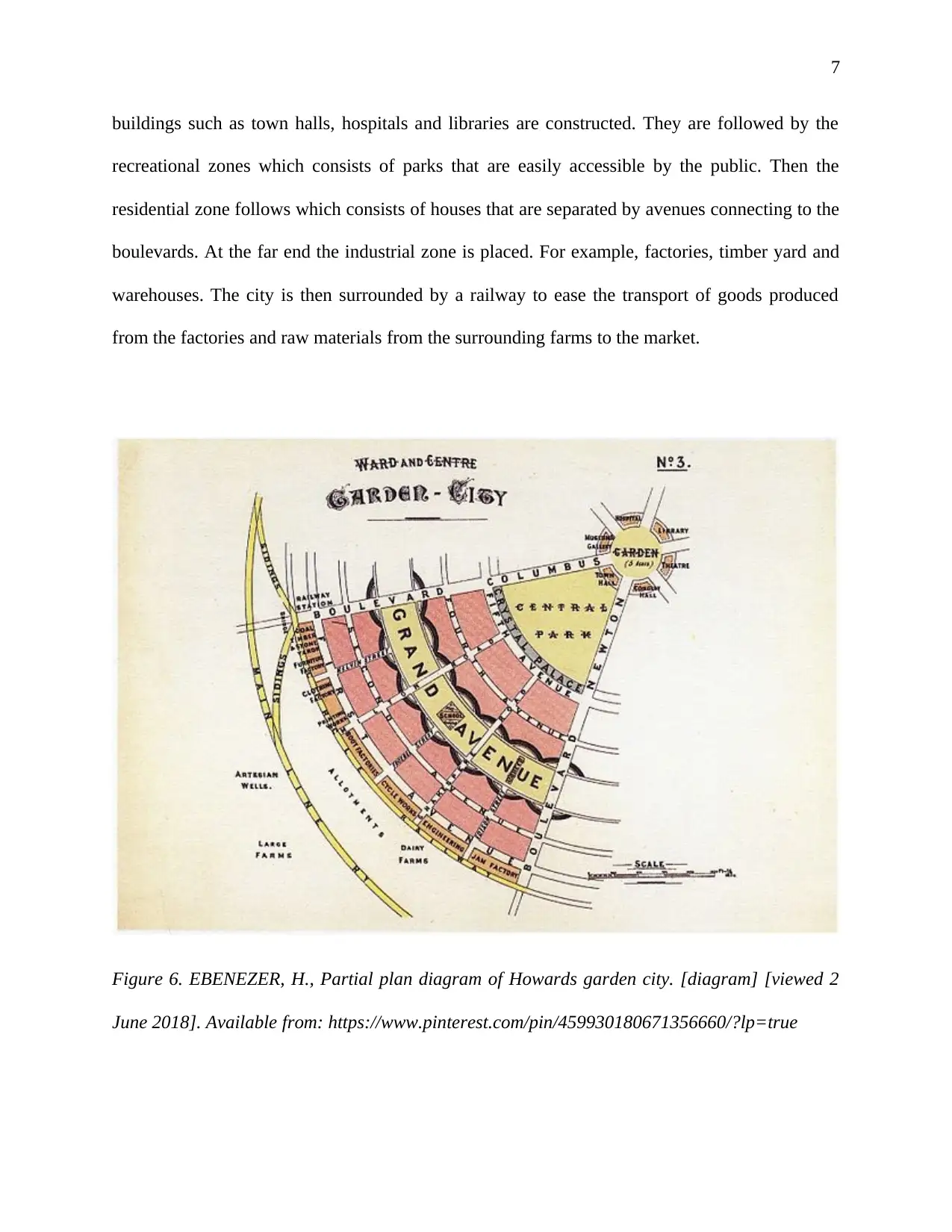
7
buildings such as town halls, hospitals and libraries are constructed. They are followed by the
recreational zones which consists of parks that are easily accessible by the public. Then the
residential zone follows which consists of houses that are separated by avenues connecting to the
boulevards. At the far end the industrial zone is placed. For example, factories, timber yard and
warehouses. The city is then surrounded by a railway to ease the transport of goods produced
from the factories and raw materials from the surrounding farms to the market.
Figure 6. EBENEZER, H., Partial plan diagram of Howards garden city. [diagram] [viewed 2
June 2018]. Available from: https://www.pinterest.com/pin/459930180671356660/?lp=true
buildings such as town halls, hospitals and libraries are constructed. They are followed by the
recreational zones which consists of parks that are easily accessible by the public. Then the
residential zone follows which consists of houses that are separated by avenues connecting to the
boulevards. At the far end the industrial zone is placed. For example, factories, timber yard and
warehouses. The city is then surrounded by a railway to ease the transport of goods produced
from the factories and raw materials from the surrounding farms to the market.
Figure 6. EBENEZER, H., Partial plan diagram of Howards garden city. [diagram] [viewed 2
June 2018]. Available from: https://www.pinterest.com/pin/459930180671356660/?lp=true
Paraphrase This Document
Need a fresh take? Get an instant paraphrase of this document with our AI Paraphraser
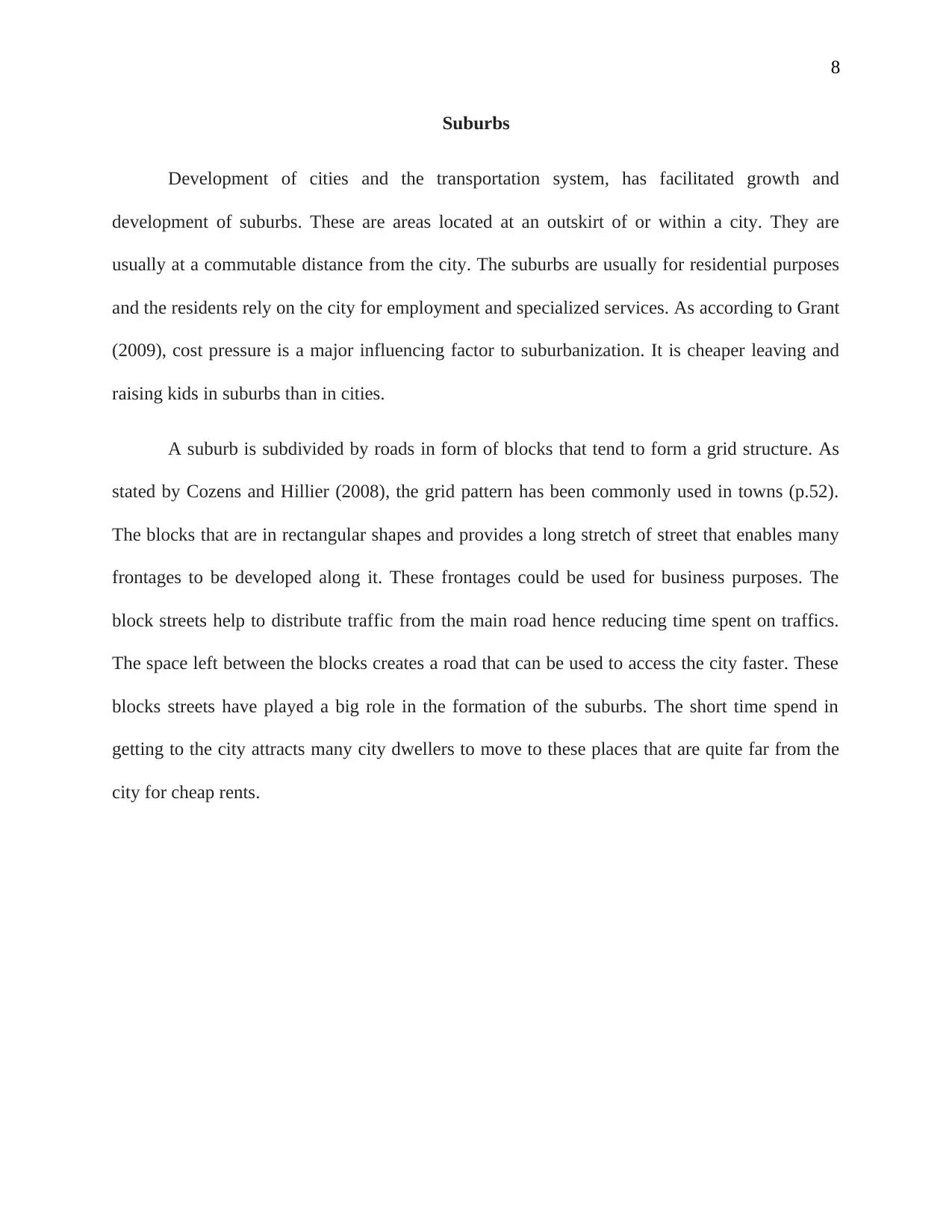
8
Suburbs
Development of cities and the transportation system, has facilitated growth and
development of suburbs. These are areas located at an outskirt of or within a city. They are
usually at a commutable distance from the city. The suburbs are usually for residential purposes
and the residents rely on the city for employment and specialized services. As according to Grant
(2009), cost pressure is a major influencing factor to suburbanization. It is cheaper leaving and
raising kids in suburbs than in cities.
A suburb is subdivided by roads in form of blocks that tend to form a grid structure. As
stated by Cozens and Hillier (2008), the grid pattern has been commonly used in towns (p.52).
The blocks that are in rectangular shapes and provides a long stretch of street that enables many
frontages to be developed along it. These frontages could be used for business purposes. The
block streets help to distribute traffic from the main road hence reducing time spent on traffics.
The space left between the blocks creates a road that can be used to access the city faster. These
blocks streets have played a big role in the formation of the suburbs. The short time spend in
getting to the city attracts many city dwellers to move to these places that are quite far from the
city for cheap rents.
Suburbs
Development of cities and the transportation system, has facilitated growth and
development of suburbs. These are areas located at an outskirt of or within a city. They are
usually at a commutable distance from the city. The suburbs are usually for residential purposes
and the residents rely on the city for employment and specialized services. As according to Grant
(2009), cost pressure is a major influencing factor to suburbanization. It is cheaper leaving and
raising kids in suburbs than in cities.
A suburb is subdivided by roads in form of blocks that tend to form a grid structure. As
stated by Cozens and Hillier (2008), the grid pattern has been commonly used in towns (p.52).
The blocks that are in rectangular shapes and provides a long stretch of street that enables many
frontages to be developed along it. These frontages could be used for business purposes. The
block streets help to distribute traffic from the main road hence reducing time spent on traffics.
The space left between the blocks creates a road that can be used to access the city faster. These
blocks streets have played a big role in the formation of the suburbs. The short time spend in
getting to the city attracts many city dwellers to move to these places that are quite far from the
city for cheap rents.
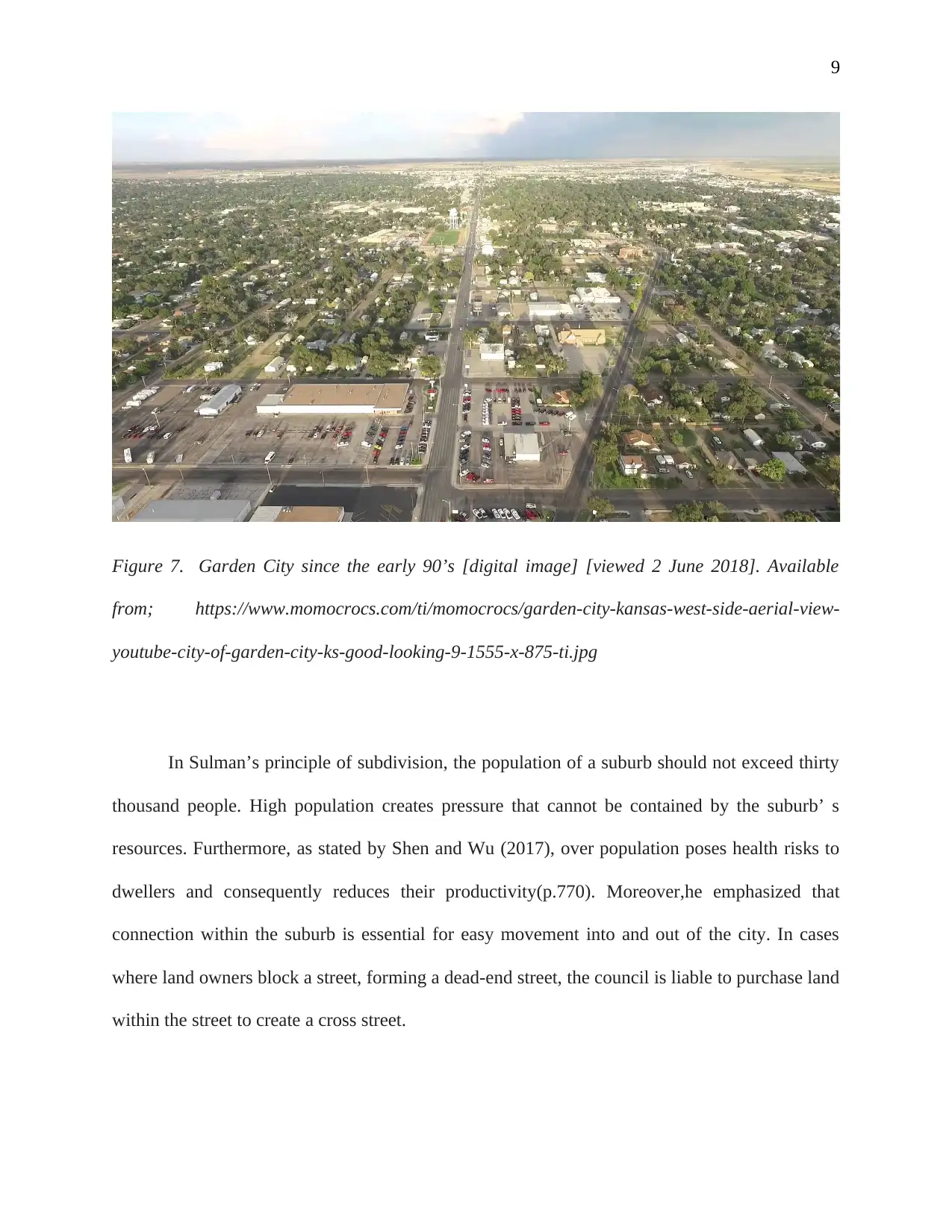
9
Figure 7. Garden City since the early 90’s [digital image] [viewed 2 June 2018]. Available
from; https://www.momocrocs.com/ti/momocrocs/garden-city-kansas-west-side-aerial-view-
youtube-city-of-garden-city-ks-good-looking-9-1555-x-875-ti.jpg
In Sulman’s principle of subdivision, the population of a suburb should not exceed thirty
thousand people. High population creates pressure that cannot be contained by the suburb’ s
resources. Furthermore, as stated by Shen and Wu (2017), over population poses health risks to
dwellers and consequently reduces their productivity(p.770). Moreover,he emphasized that
connection within the suburb is essential for easy movement into and out of the city. In cases
where land owners block a street, forming a dead-end street, the council is liable to purchase land
within the street to create a cross street.
Figure 7. Garden City since the early 90’s [digital image] [viewed 2 June 2018]. Available
from; https://www.momocrocs.com/ti/momocrocs/garden-city-kansas-west-side-aerial-view-
youtube-city-of-garden-city-ks-good-looking-9-1555-x-875-ti.jpg
In Sulman’s principle of subdivision, the population of a suburb should not exceed thirty
thousand people. High population creates pressure that cannot be contained by the suburb’ s
resources. Furthermore, as stated by Shen and Wu (2017), over population poses health risks to
dwellers and consequently reduces their productivity(p.770). Moreover,he emphasized that
connection within the suburb is essential for easy movement into and out of the city. In cases
where land owners block a street, forming a dead-end street, the council is liable to purchase land
within the street to create a cross street.
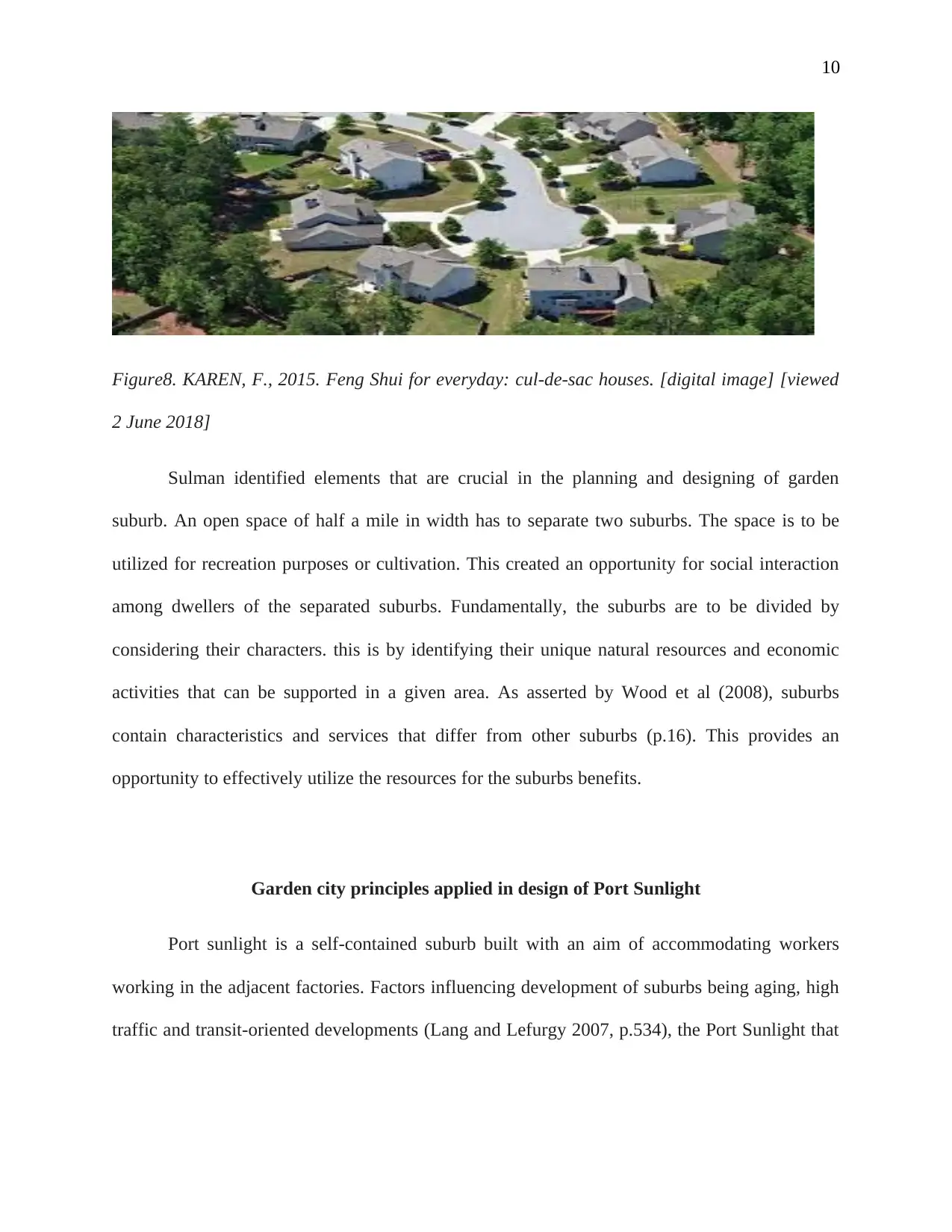
10
Figure8. KAREN, F., 2015. Feng Shui for everyday: cul-de-sac houses. [digital image] [viewed
2 June 2018]
Sulman identified elements that are crucial in the planning and designing of garden
suburb. An open space of half a mile in width has to separate two suburbs. The space is to be
utilized for recreation purposes or cultivation. This created an opportunity for social interaction
among dwellers of the separated suburbs. Fundamentally, the suburbs are to be divided by
considering their characters. this is by identifying their unique natural resources and economic
activities that can be supported in a given area. As asserted by Wood et al (2008), suburbs
contain characteristics and services that differ from other suburbs (p.16). This provides an
opportunity to effectively utilize the resources for the suburbs benefits.
Garden city principles applied in design of Port Sunlight
Port sunlight is a self-contained suburb built with an aim of accommodating workers
working in the adjacent factories. Factors influencing development of suburbs being aging, high
traffic and transit-oriented developments (Lang and Lefurgy 2007, p.534), the Port Sunlight that
Figure8. KAREN, F., 2015. Feng Shui for everyday: cul-de-sac houses. [digital image] [viewed
2 June 2018]
Sulman identified elements that are crucial in the planning and designing of garden
suburb. An open space of half a mile in width has to separate two suburbs. The space is to be
utilized for recreation purposes or cultivation. This created an opportunity for social interaction
among dwellers of the separated suburbs. Fundamentally, the suburbs are to be divided by
considering their characters. this is by identifying their unique natural resources and economic
activities that can be supported in a given area. As asserted by Wood et al (2008), suburbs
contain characteristics and services that differ from other suburbs (p.16). This provides an
opportunity to effectively utilize the resources for the suburbs benefits.
Garden city principles applied in design of Port Sunlight
Port sunlight is a self-contained suburb built with an aim of accommodating workers
working in the adjacent factories. Factors influencing development of suburbs being aging, high
traffic and transit-oriented developments (Lang and Lefurgy 2007, p.534), the Port Sunlight that
Secure Best Marks with AI Grader
Need help grading? Try our AI Grader for instant feedback on your assignments.
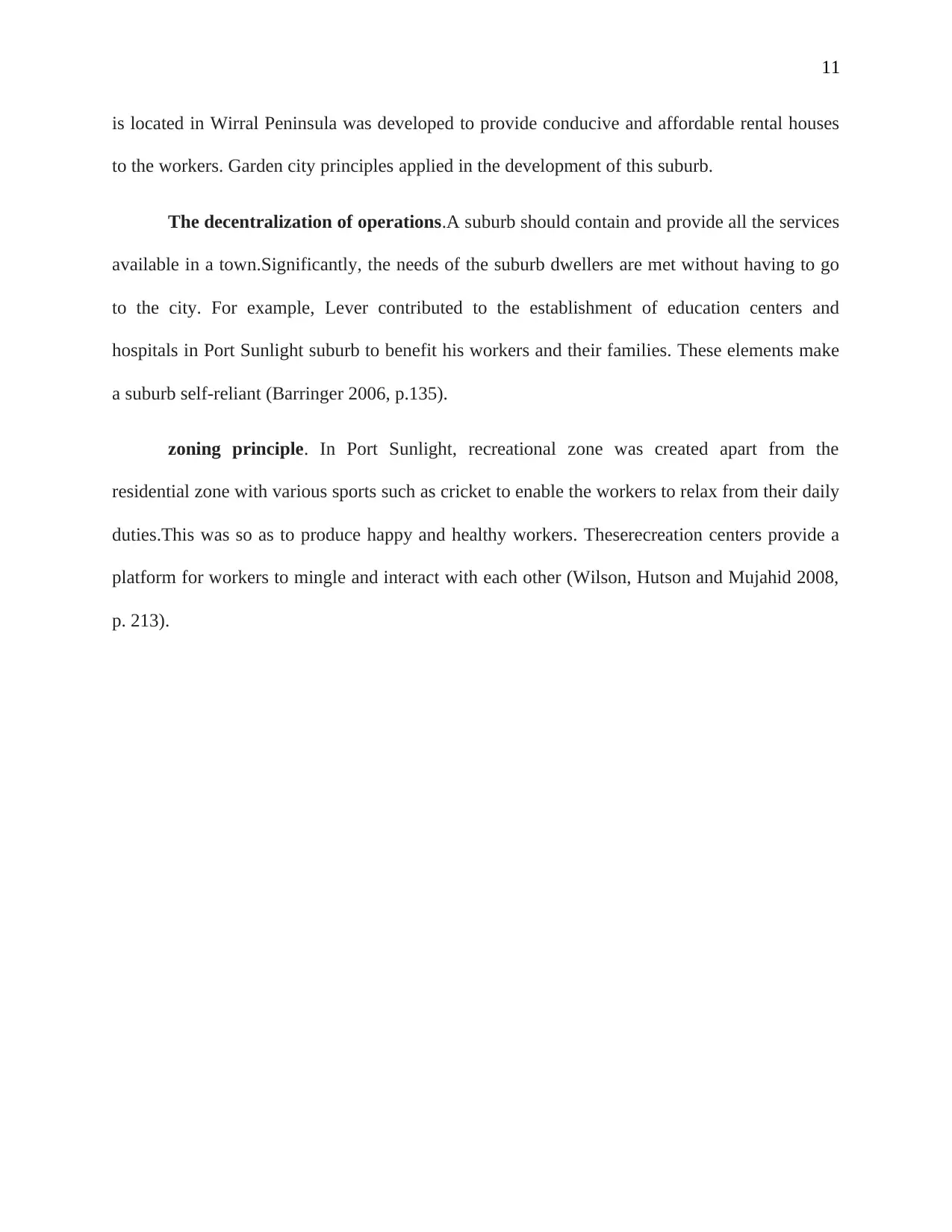
11
is located in Wirral Peninsula was developed to provide conducive and affordable rental houses
to the workers. Garden city principles applied in the development of this suburb.
The decentralization of operations.A suburb should contain and provide all the services
available in a town.Significantly, the needs of the suburb dwellers are met without having to go
to the city. For example, Lever contributed to the establishment of education centers and
hospitals in Port Sunlight suburb to benefit his workers and their families. These elements make
a suburb self-reliant (Barringer 2006, p.135).
zoning principle. In Port Sunlight, recreational zone was created apart from the
residential zone with various sports such as cricket to enable the workers to relax from their daily
duties.This was so as to produce happy and healthy workers. Theserecreation centers provide a
platform for workers to mingle and interact with each other (Wilson, Hutson and Mujahid 2008,
p. 213).
is located in Wirral Peninsula was developed to provide conducive and affordable rental houses
to the workers. Garden city principles applied in the development of this suburb.
The decentralization of operations.A suburb should contain and provide all the services
available in a town.Significantly, the needs of the suburb dwellers are met without having to go
to the city. For example, Lever contributed to the establishment of education centers and
hospitals in Port Sunlight suburb to benefit his workers and their families. These elements make
a suburb self-reliant (Barringer 2006, p.135).
zoning principle. In Port Sunlight, recreational zone was created apart from the
residential zone with various sports such as cricket to enable the workers to relax from their daily
duties.This was so as to produce happy and healthy workers. Theserecreation centers provide a
platform for workers to mingle and interact with each other (Wilson, Hutson and Mujahid 2008,
p. 213).
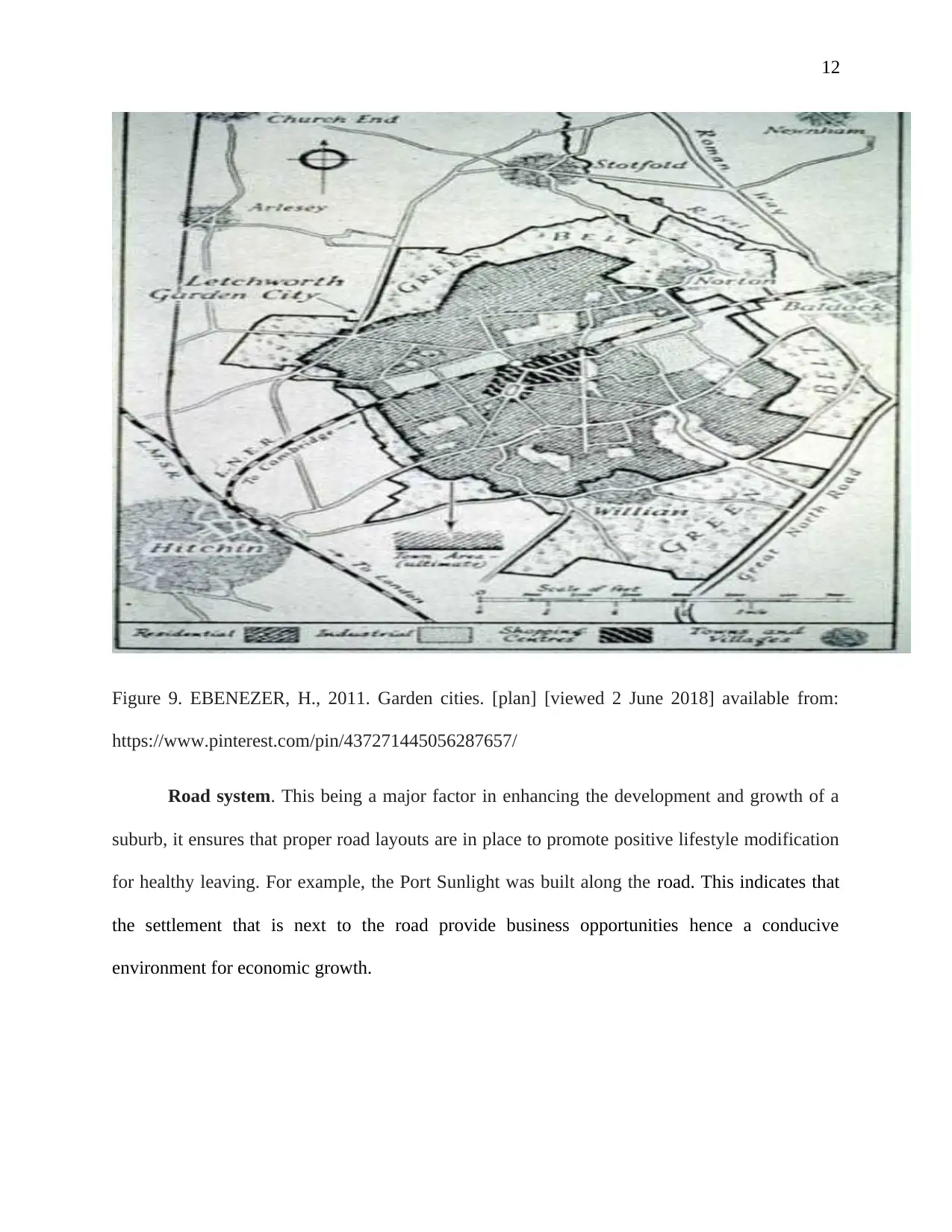
12
Figure 9. EBENEZER, H., 2011. Garden cities. [plan] [viewed 2 June 2018] available from:
https://www.pinterest.com/pin/437271445056287657/
Road system. This being a major factor in enhancing the development and growth of a
suburb, it ensures that proper road layouts are in place to promote positive lifestyle modification
for healthy leaving. For example, the Port Sunlight was built along the road. This indicates that
the settlement that is next to the road provide business opportunities hence a conducive
environment for economic growth.
Figure 9. EBENEZER, H., 2011. Garden cities. [plan] [viewed 2 June 2018] available from:
https://www.pinterest.com/pin/437271445056287657/
Road system. This being a major factor in enhancing the development and growth of a
suburb, it ensures that proper road layouts are in place to promote positive lifestyle modification
for healthy leaving. For example, the Port Sunlight was built along the road. This indicates that
the settlement that is next to the road provide business opportunities hence a conducive
environment for economic growth.
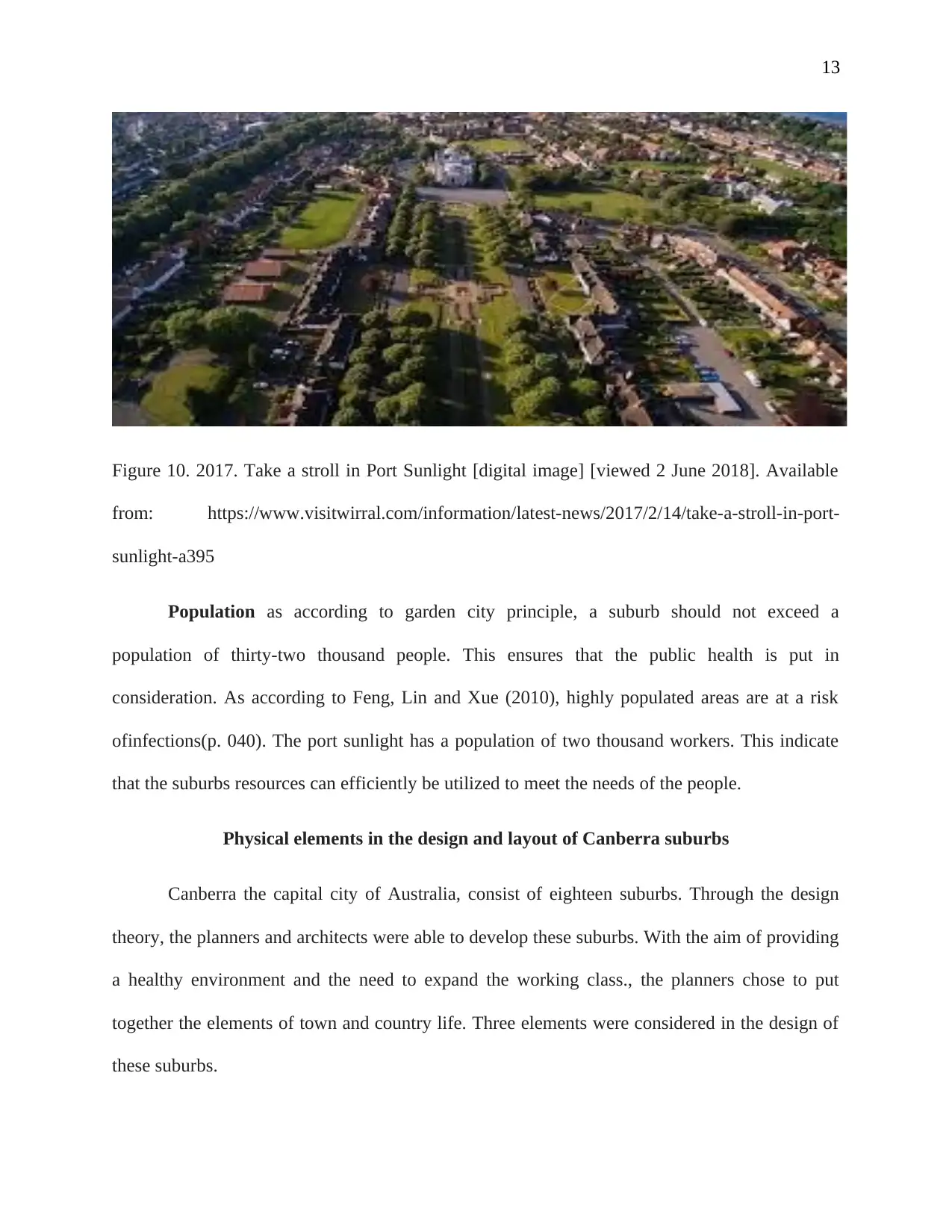
13
Figure 10. 2017. Take a stroll in Port Sunlight [digital image] [viewed 2 June 2018]. Available
from: https://www.visitwirral.com/information/latest-news/2017/2/14/take-a-stroll-in-port-
sunlight-a395
Population as according to garden city principle, a suburb should not exceed a
population of thirty-two thousand people. This ensures that the public health is put in
consideration. As according to Feng, Lin and Xue (2010), highly populated areas are at a risk
ofinfections(p. 040). The port sunlight has a population of two thousand workers. This indicate
that the suburbs resources can efficiently be utilized to meet the needs of the people.
Physical elements in the design and layout of Canberra suburbs
Canberra the capital city of Australia, consist of eighteen suburbs. Through the design
theory, the planners and architects were able to develop these suburbs. With the aim of providing
a healthy environment and the need to expand the working class., the planners chose to put
together the elements of town and country life. Three elements were considered in the design of
these suburbs.
Figure 10. 2017. Take a stroll in Port Sunlight [digital image] [viewed 2 June 2018]. Available
from: https://www.visitwirral.com/information/latest-news/2017/2/14/take-a-stroll-in-port-
sunlight-a395
Population as according to garden city principle, a suburb should not exceed a
population of thirty-two thousand people. This ensures that the public health is put in
consideration. As according to Feng, Lin and Xue (2010), highly populated areas are at a risk
ofinfections(p. 040). The port sunlight has a population of two thousand workers. This indicate
that the suburbs resources can efficiently be utilized to meet the needs of the people.
Physical elements in the design and layout of Canberra suburbs
Canberra the capital city of Australia, consist of eighteen suburbs. Through the design
theory, the planners and architects were able to develop these suburbs. With the aim of providing
a healthy environment and the need to expand the working class., the planners chose to put
together the elements of town and country life. Three elements were considered in the design of
these suburbs.
Paraphrase This Document
Need a fresh take? Get an instant paraphrase of this document with our AI Paraphraser
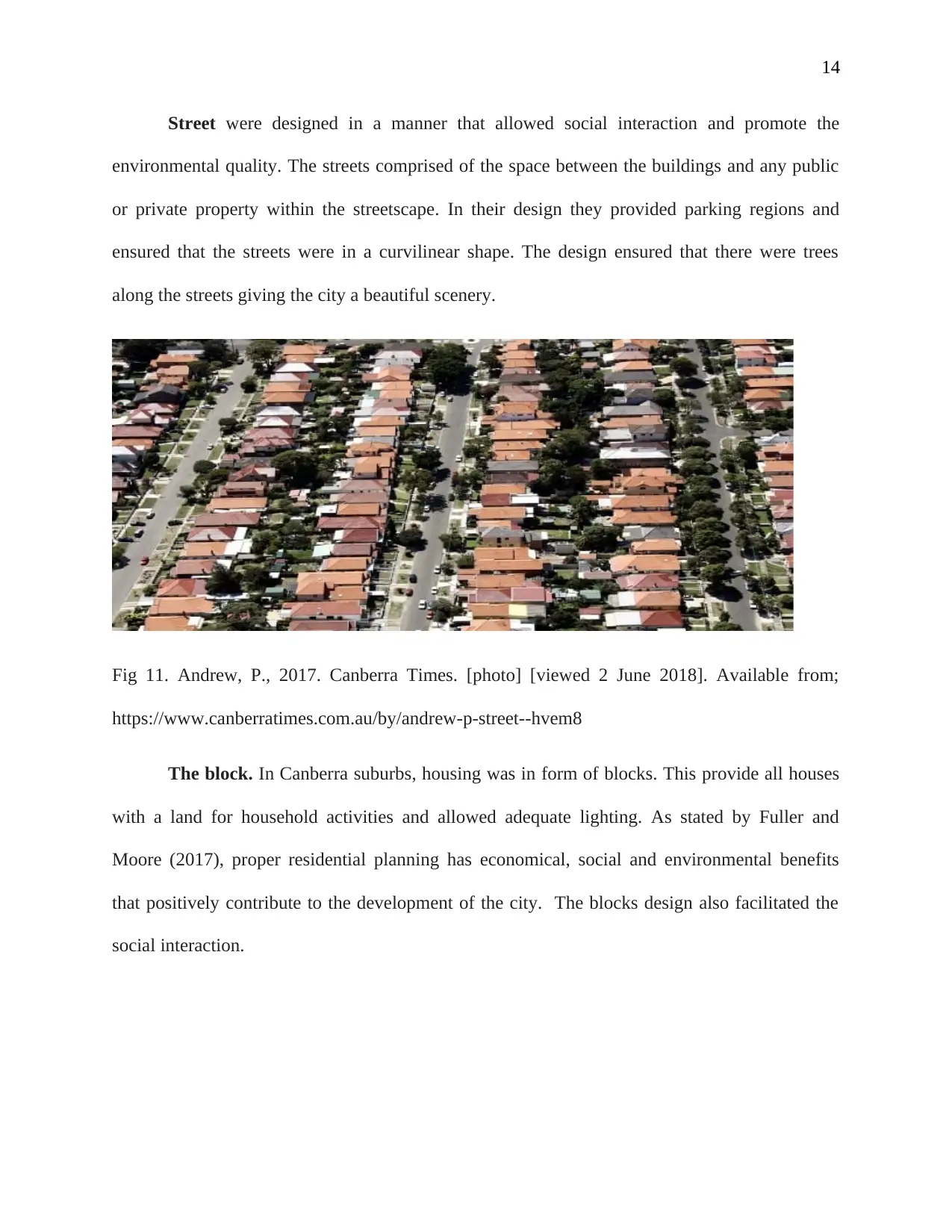
14
Street were designed in a manner that allowed social interaction and promote the
environmental quality. The streets comprised of the space between the buildings and any public
or private property within the streetscape. In their design they provided parking regions and
ensured that the streets were in a curvilinear shape. The design ensured that there were trees
along the streets giving the city a beautiful scenery.
Fig 11. Andrew, P., 2017. Canberra Times. [photo] [viewed 2 June 2018]. Available from;
https://www.canberratimes.com.au/by/andrew-p-street--hvem8
The block. In Canberra suburbs, housing was in form of blocks. This provide all houses
with a land for household activities and allowed adequate lighting. As stated by Fuller and
Moore (2017), proper residential planning has economical, social and environmental benefits
that positively contribute to the development of the city. The blocks design also facilitated the
social interaction.
Street were designed in a manner that allowed social interaction and promote the
environmental quality. The streets comprised of the space between the buildings and any public
or private property within the streetscape. In their design they provided parking regions and
ensured that the streets were in a curvilinear shape. The design ensured that there were trees
along the streets giving the city a beautiful scenery.
Fig 11. Andrew, P., 2017. Canberra Times. [photo] [viewed 2 June 2018]. Available from;
https://www.canberratimes.com.au/by/andrew-p-street--hvem8
The block. In Canberra suburbs, housing was in form of blocks. This provide all houses
with a land for household activities and allowed adequate lighting. As stated by Fuller and
Moore (2017), proper residential planning has economical, social and environmental benefits
that positively contribute to the development of the city. The blocks design also facilitated the
social interaction.
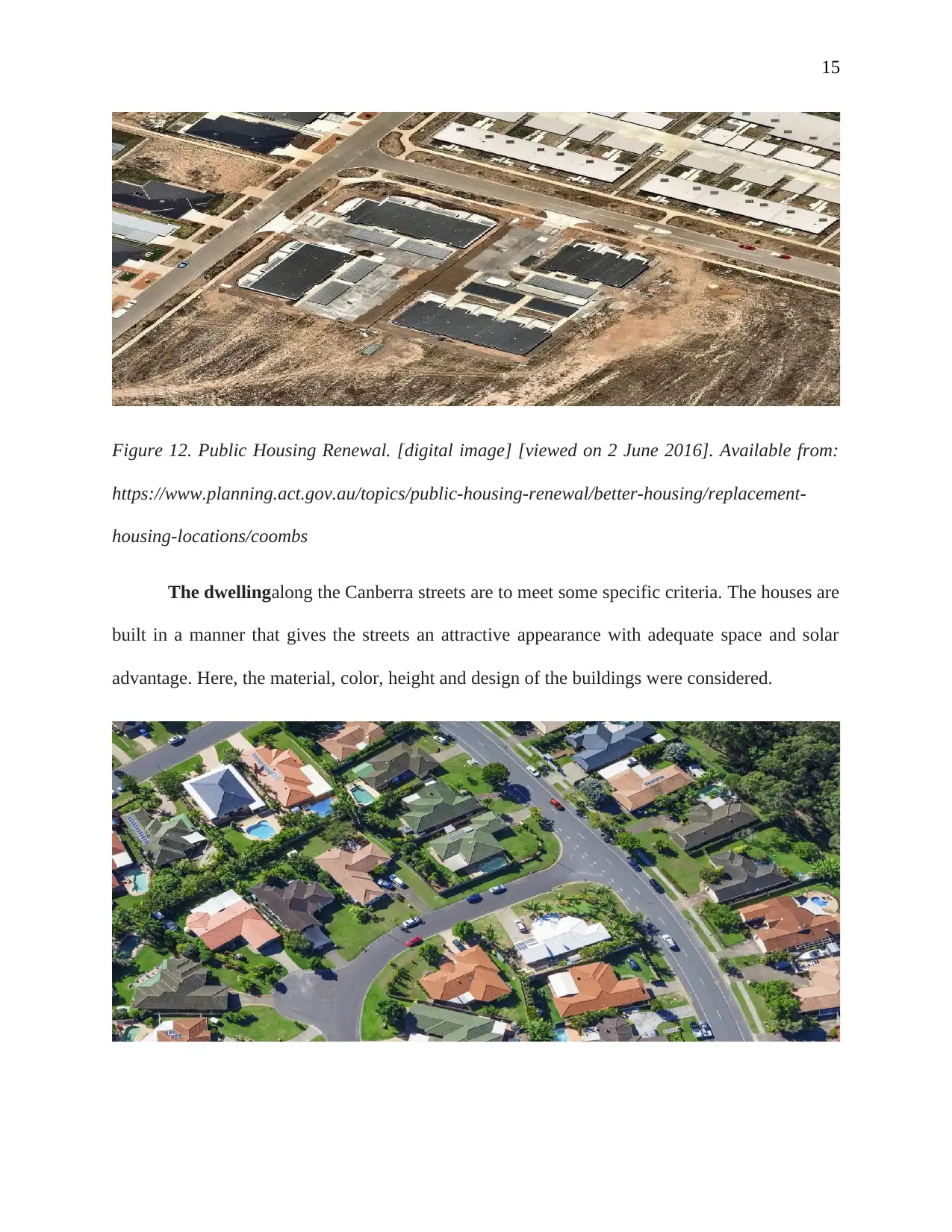
15
Figure 12. Public Housing Renewal. [digital image] [viewed on 2 June 2016]. Available from:
https://www.planning.act.gov.au/topics/public-housing-renewal/better-housing/replacement-
housing-locations/coombs
The dwellingalong the Canberra streets are to meet some specific criteria. The houses are
built in a manner that gives the streets an attractive appearance with adequate space and solar
advantage. Here, the material, color, height and design of the buildings were considered.
Figure 12. Public Housing Renewal. [digital image] [viewed on 2 June 2016]. Available from:
https://www.planning.act.gov.au/topics/public-housing-renewal/better-housing/replacement-
housing-locations/coombs
The dwellingalong the Canberra streets are to meet some specific criteria. The houses are
built in a manner that gives the streets an attractive appearance with adequate space and solar
advantage. Here, the material, color, height and design of the buildings were considered.
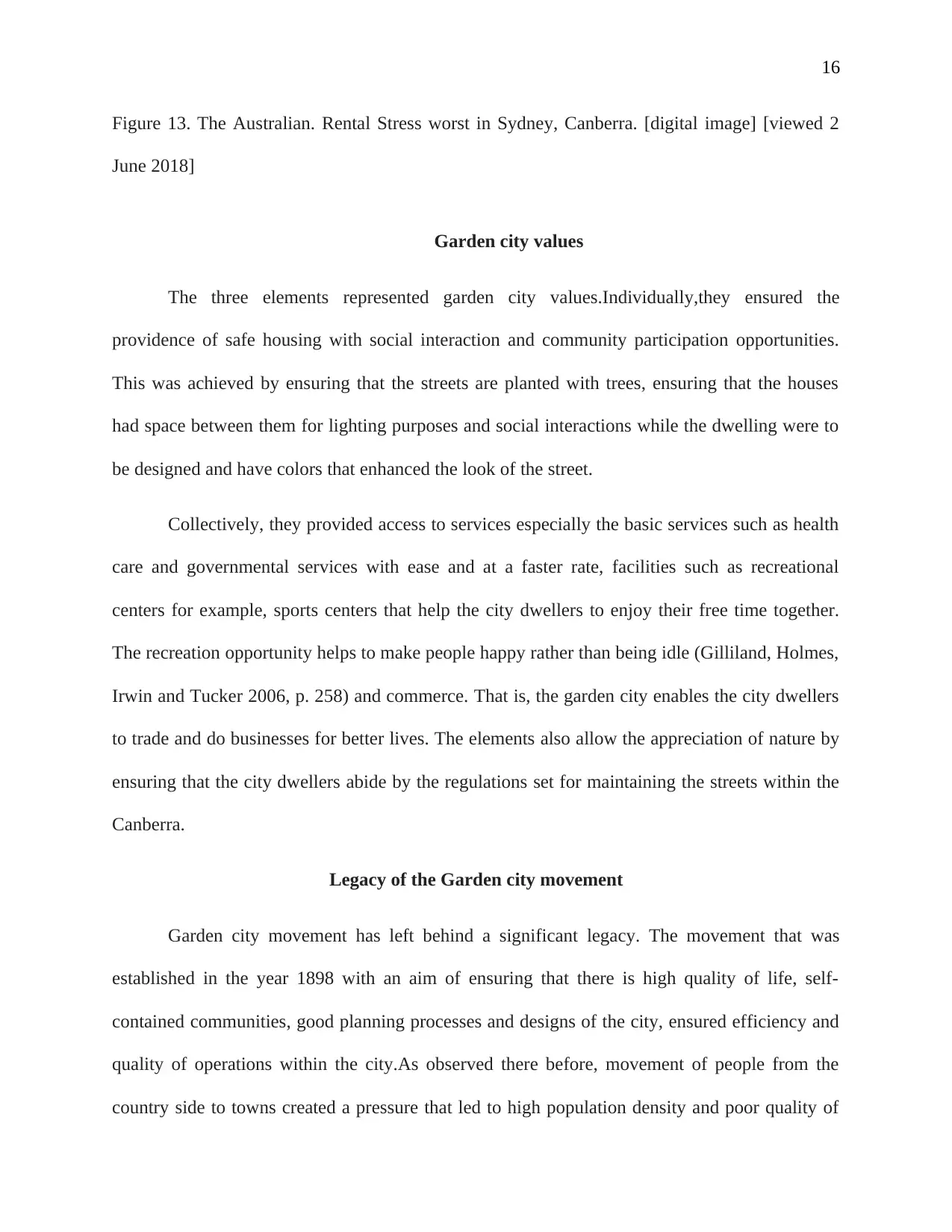
16
Figure 13. The Australian. Rental Stress worst in Sydney, Canberra. [digital image] [viewed 2
June 2018]
Garden city values
The three elements represented garden city values.Individually,they ensured the
providence of safe housing with social interaction and community participation opportunities.
This was achieved by ensuring that the streets are planted with trees, ensuring that the houses
had space between them for lighting purposes and social interactions while the dwelling were to
be designed and have colors that enhanced the look of the street.
Collectively, they provided access to services especially the basic services such as health
care and governmental services with ease and at a faster rate, facilities such as recreational
centers for example, sports centers that help the city dwellers to enjoy their free time together.
The recreation opportunity helps to make people happy rather than being idle (Gilliland, Holmes,
Irwin and Tucker 2006, p. 258) and commerce. That is, the garden city enables the city dwellers
to trade and do businesses for better lives. The elements also allow the appreciation of nature by
ensuring that the city dwellers abide by the regulations set for maintaining the streets within the
Canberra.
Legacy of the Garden city movement
Garden city movement has left behind a significant legacy. The movement that was
established in the year 1898 with an aim of ensuring that there is high quality of life, self-
contained communities, good planning processes and designs of the city, ensured efficiency and
quality of operations within the city.As observed there before, movement of people from the
country side to towns created a pressure that led to high population density and poor quality of
Figure 13. The Australian. Rental Stress worst in Sydney, Canberra. [digital image] [viewed 2
June 2018]
Garden city values
The three elements represented garden city values.Individually,they ensured the
providence of safe housing with social interaction and community participation opportunities.
This was achieved by ensuring that the streets are planted with trees, ensuring that the houses
had space between them for lighting purposes and social interactions while the dwelling were to
be designed and have colors that enhanced the look of the street.
Collectively, they provided access to services especially the basic services such as health
care and governmental services with ease and at a faster rate, facilities such as recreational
centers for example, sports centers that help the city dwellers to enjoy their free time together.
The recreation opportunity helps to make people happy rather than being idle (Gilliland, Holmes,
Irwin and Tucker 2006, p. 258) and commerce. That is, the garden city enables the city dwellers
to trade and do businesses for better lives. The elements also allow the appreciation of nature by
ensuring that the city dwellers abide by the regulations set for maintaining the streets within the
Canberra.
Legacy of the Garden city movement
Garden city movement has left behind a significant legacy. The movement that was
established in the year 1898 with an aim of ensuring that there is high quality of life, self-
contained communities, good planning processes and designs of the city, ensured efficiency and
quality of operations within the city.As observed there before, movement of people from the
country side to towns created a pressure that led to high population density and poor quality of
Secure Best Marks with AI Grader
Need help grading? Try our AI Grader for instant feedback on your assignments.
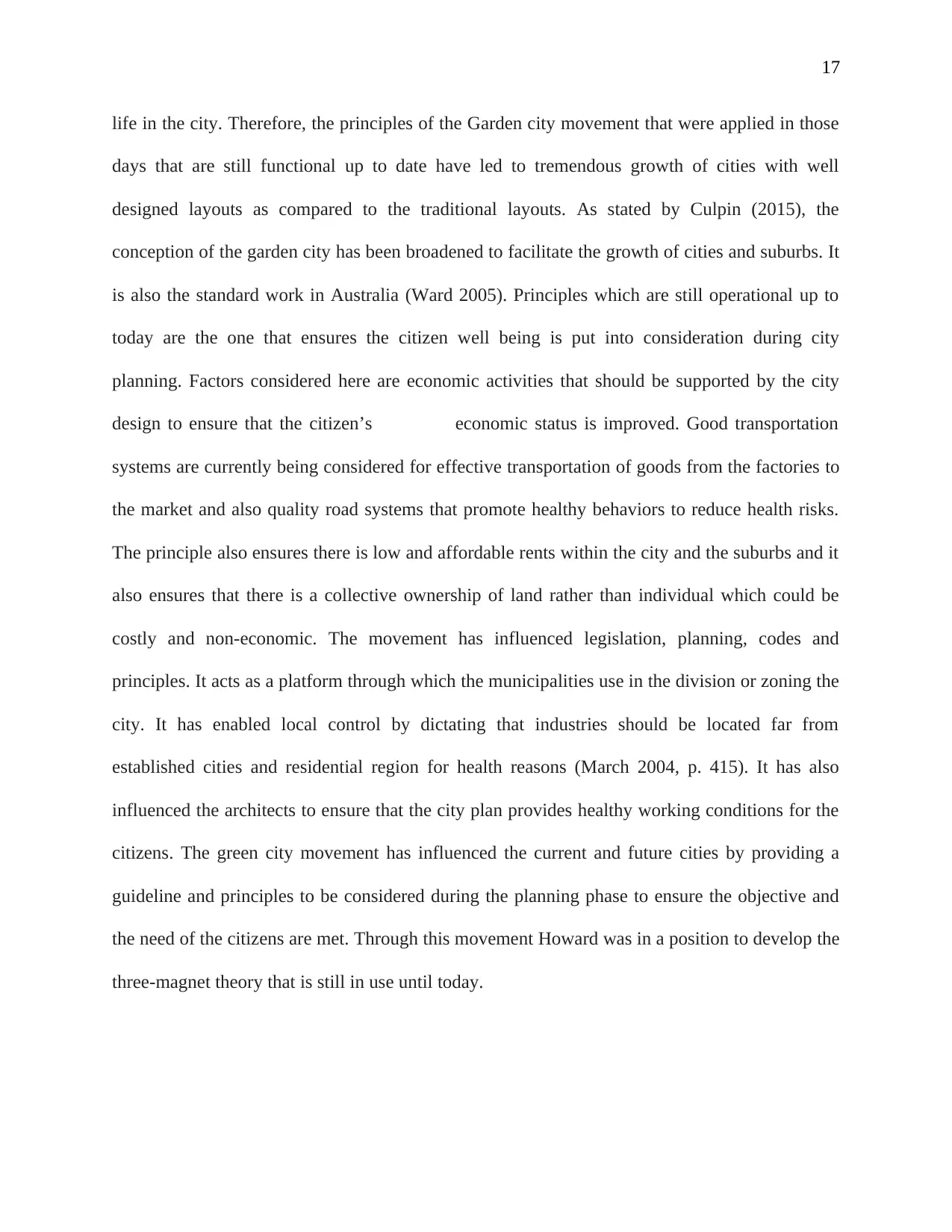
17
life in the city. Therefore, the principles of the Garden city movement that were applied in those
days that are still functional up to date have led to tremendous growth of cities with well
designed layouts as compared to the traditional layouts. As stated by Culpin (2015), the
conception of the garden city has been broadened to facilitate the growth of cities and suburbs. It
is also the standard work in Australia (Ward 2005). Principles which are still operational up to
today are the one that ensures the citizen well being is put into consideration during city
planning. Factors considered here are economic activities that should be supported by the city
design to ensure that the citizen’s economic status is improved. Good transportation
systems are currently being considered for effective transportation of goods from the factories to
the market and also quality road systems that promote healthy behaviors to reduce health risks.
The principle also ensures there is low and affordable rents within the city and the suburbs and it
also ensures that there is a collective ownership of land rather than individual which could be
costly and non-economic. The movement has influenced legislation, planning, codes and
principles. It acts as a platform through which the municipalities use in the division or zoning the
city. It has enabled local control by dictating that industries should be located far from
established cities and residential region for health reasons (March 2004, p. 415). It has also
influenced the architects to ensure that the city plan provides healthy working conditions for the
citizens. The green city movement has influenced the current and future cities by providing a
guideline and principles to be considered during the planning phase to ensure the objective and
the need of the citizens are met. Through this movement Howard was in a position to develop the
three-magnet theory that is still in use until today.
life in the city. Therefore, the principles of the Garden city movement that were applied in those
days that are still functional up to date have led to tremendous growth of cities with well
designed layouts as compared to the traditional layouts. As stated by Culpin (2015), the
conception of the garden city has been broadened to facilitate the growth of cities and suburbs. It
is also the standard work in Australia (Ward 2005). Principles which are still operational up to
today are the one that ensures the citizen well being is put into consideration during city
planning. Factors considered here are economic activities that should be supported by the city
design to ensure that the citizen’s economic status is improved. Good transportation
systems are currently being considered for effective transportation of goods from the factories to
the market and also quality road systems that promote healthy behaviors to reduce health risks.
The principle also ensures there is low and affordable rents within the city and the suburbs and it
also ensures that there is a collective ownership of land rather than individual which could be
costly and non-economic. The movement has influenced legislation, planning, codes and
principles. It acts as a platform through which the municipalities use in the division or zoning the
city. It has enabled local control by dictating that industries should be located far from
established cities and residential region for health reasons (March 2004, p. 415). It has also
influenced the architects to ensure that the city plan provides healthy working conditions for the
citizens. The green city movement has influenced the current and future cities by providing a
guideline and principles to be considered during the planning phase to ensure the objective and
the need of the citizens are met. Through this movement Howard was in a position to develop the
three-magnet theory that is still in use until today.
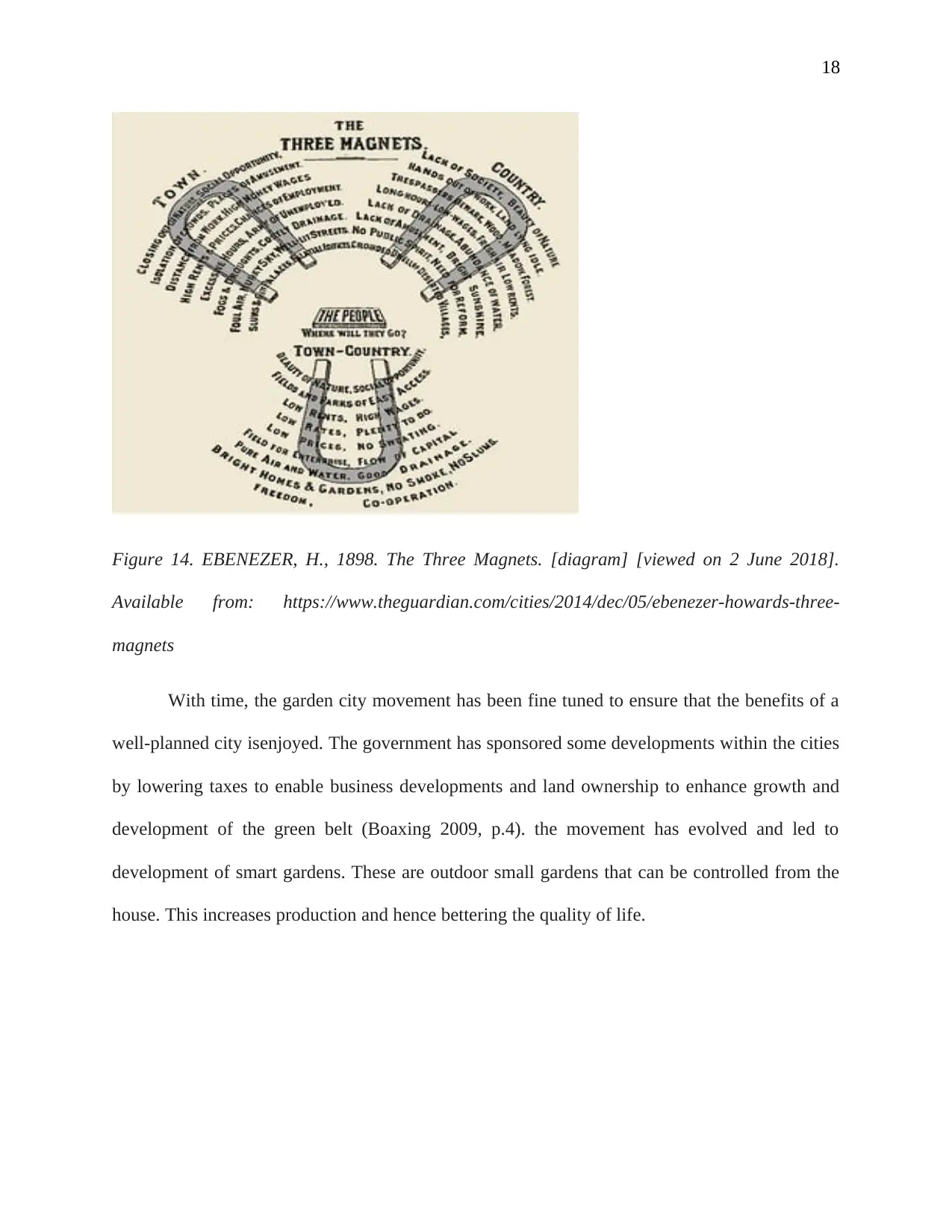
18
Figure 14. EBENEZER, H., 1898. The Three Magnets. [diagram] [viewed on 2 June 2018].
Available from: https://www.theguardian.com/cities/2014/dec/05/ebenezer-howards-three-
magnets
With time, the garden city movement has been fine tuned to ensure that the benefits of a
well-planned city isenjoyed. The government has sponsored some developments within the cities
by lowering taxes to enable business developments and land ownership to enhance growth and
development of the green belt (Boaxing 2009, p.4). the movement has evolved and led to
development of smart gardens. These are outdoor small gardens that can be controlled from the
house. This increases production and hence bettering the quality of life.
Figure 14. EBENEZER, H., 1898. The Three Magnets. [diagram] [viewed on 2 June 2018].
Available from: https://www.theguardian.com/cities/2014/dec/05/ebenezer-howards-three-
magnets
With time, the garden city movement has been fine tuned to ensure that the benefits of a
well-planned city isenjoyed. The government has sponsored some developments within the cities
by lowering taxes to enable business developments and land ownership to enhance growth and
development of the green belt (Boaxing 2009, p.4). the movement has evolved and led to
development of smart gardens. These are outdoor small gardens that can be controlled from the
house. This increases production and hence bettering the quality of life.
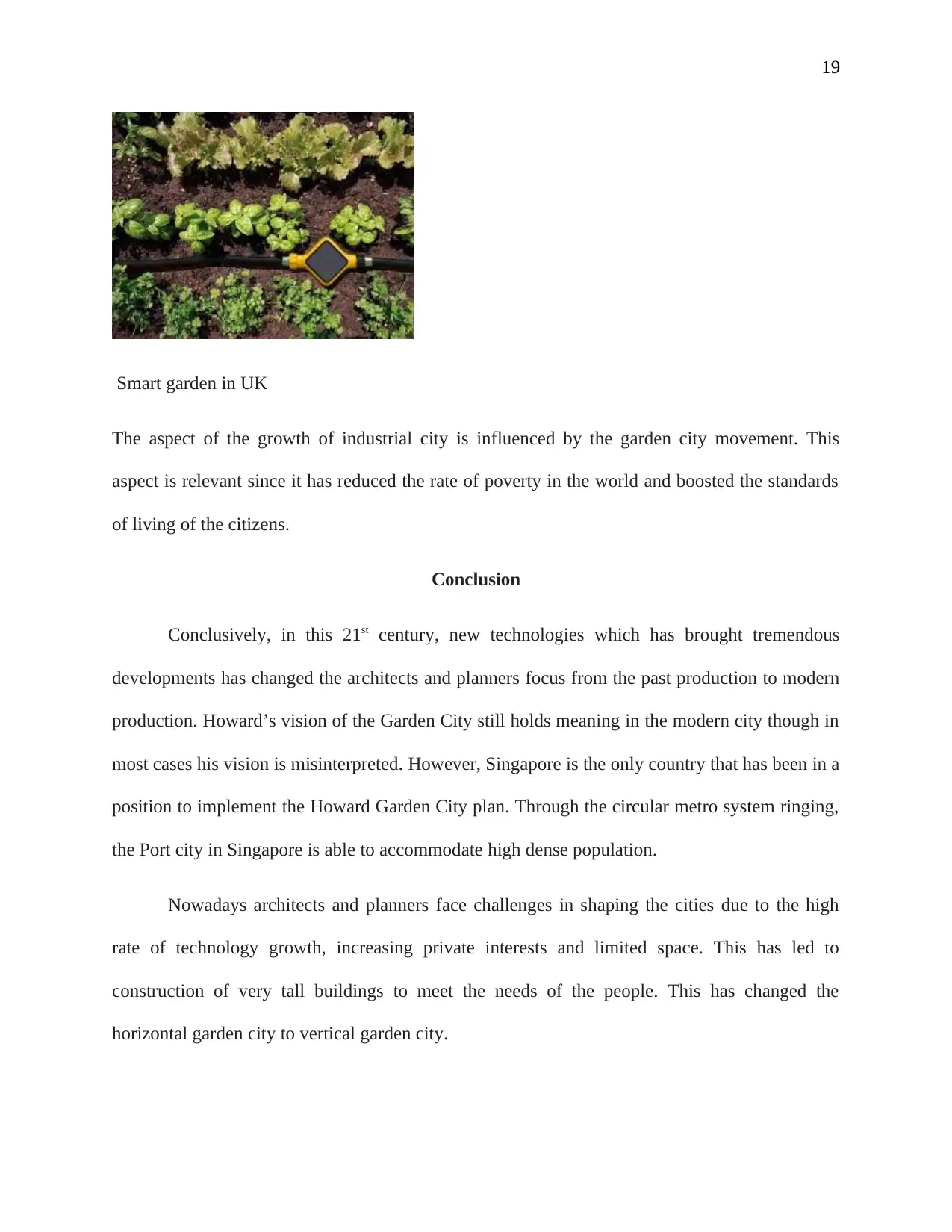
19
Smart garden in UK
The aspect of the growth of industrial city is influenced by the garden city movement. This
aspect is relevant since it has reduced the rate of poverty in the world and boosted the standards
of living of the citizens.
Conclusion
Conclusively, in this 21st century, new technologies which has brought tremendous
developments has changed the architects and planners focus from the past production to modern
production. Howard’s vision of the Garden City still holds meaning in the modern city though in
most cases his vision is misinterpreted. However, Singapore is the only country that has been in a
position to implement the Howard Garden City plan. Through the circular metro system ringing,
the Port city in Singapore is able to accommodate high dense population.
Nowadays architects and planners face challenges in shaping the cities due to the high
rate of technology growth, increasing private interests and limited space. This has led to
construction of very tall buildings to meet the needs of the people. This has changed the
horizontal garden city to vertical garden city.
Smart garden in UK
The aspect of the growth of industrial city is influenced by the garden city movement. This
aspect is relevant since it has reduced the rate of poverty in the world and boosted the standards
of living of the citizens.
Conclusion
Conclusively, in this 21st century, new technologies which has brought tremendous
developments has changed the architects and planners focus from the past production to modern
production. Howard’s vision of the Garden City still holds meaning in the modern city though in
most cases his vision is misinterpreted. However, Singapore is the only country that has been in a
position to implement the Howard Garden City plan. Through the circular metro system ringing,
the Port city in Singapore is able to accommodate high dense population.
Nowadays architects and planners face challenges in shaping the cities due to the high
rate of technology growth, increasing private interests and limited space. This has led to
construction of very tall buildings to meet the needs of the people. This has changed the
horizontal garden city to vertical garden city.
Paraphrase This Document
Need a fresh take? Get an instant paraphrase of this document with our AI Paraphraser
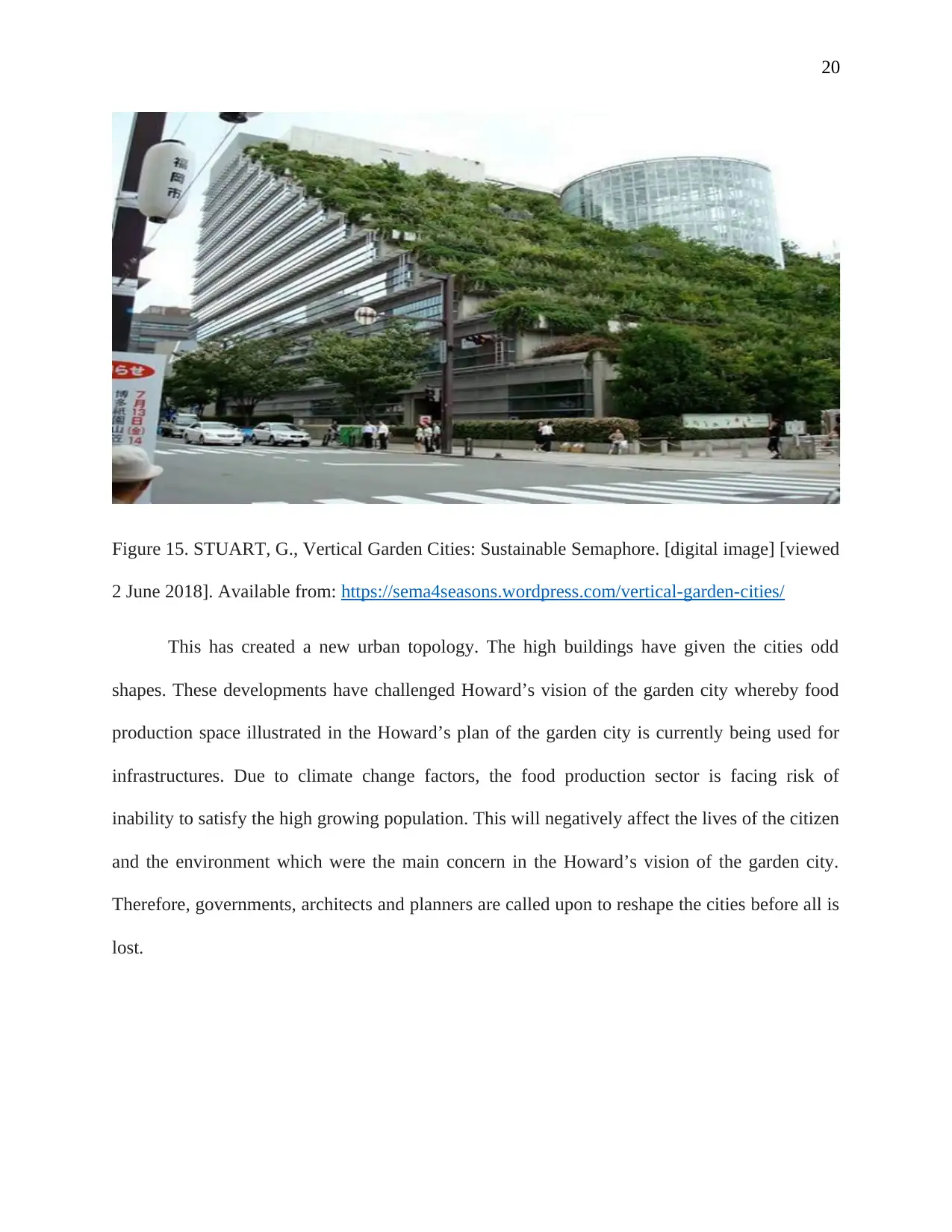
20
Figure 15. STUART, G., Vertical Garden Cities: Sustainable Semaphore. [digital image] [viewed
2 June 2018]. Available from: https://sema4seasons.wordpress.com/vertical-garden-cities/
This has created a new urban topology. The high buildings have given the cities odd
shapes. These developments have challenged Howard’s vision of the garden city whereby food
production space illustrated in the Howard’s plan of the garden city is currently being used for
infrastructures. Due to climate change factors, the food production sector is facing risk of
inability to satisfy the high growing population. This will negatively affect the lives of the citizen
and the environment which were the main concern in the Howard’s vision of the garden city.
Therefore, governments, architects and planners are called upon to reshape the cities before all is
lost.
Figure 15. STUART, G., Vertical Garden Cities: Sustainable Semaphore. [digital image] [viewed
2 June 2018]. Available from: https://sema4seasons.wordpress.com/vertical-garden-cities/
This has created a new urban topology. The high buildings have given the cities odd
shapes. These developments have challenged Howard’s vision of the garden city whereby food
production space illustrated in the Howard’s plan of the garden city is currently being used for
infrastructures. Due to climate change factors, the food production sector is facing risk of
inability to satisfy the high growing population. This will negatively affect the lives of the citizen
and the environment which were the main concern in the Howard’s vision of the garden city.
Therefore, governments, architects and planners are called upon to reshape the cities before all is
lost.
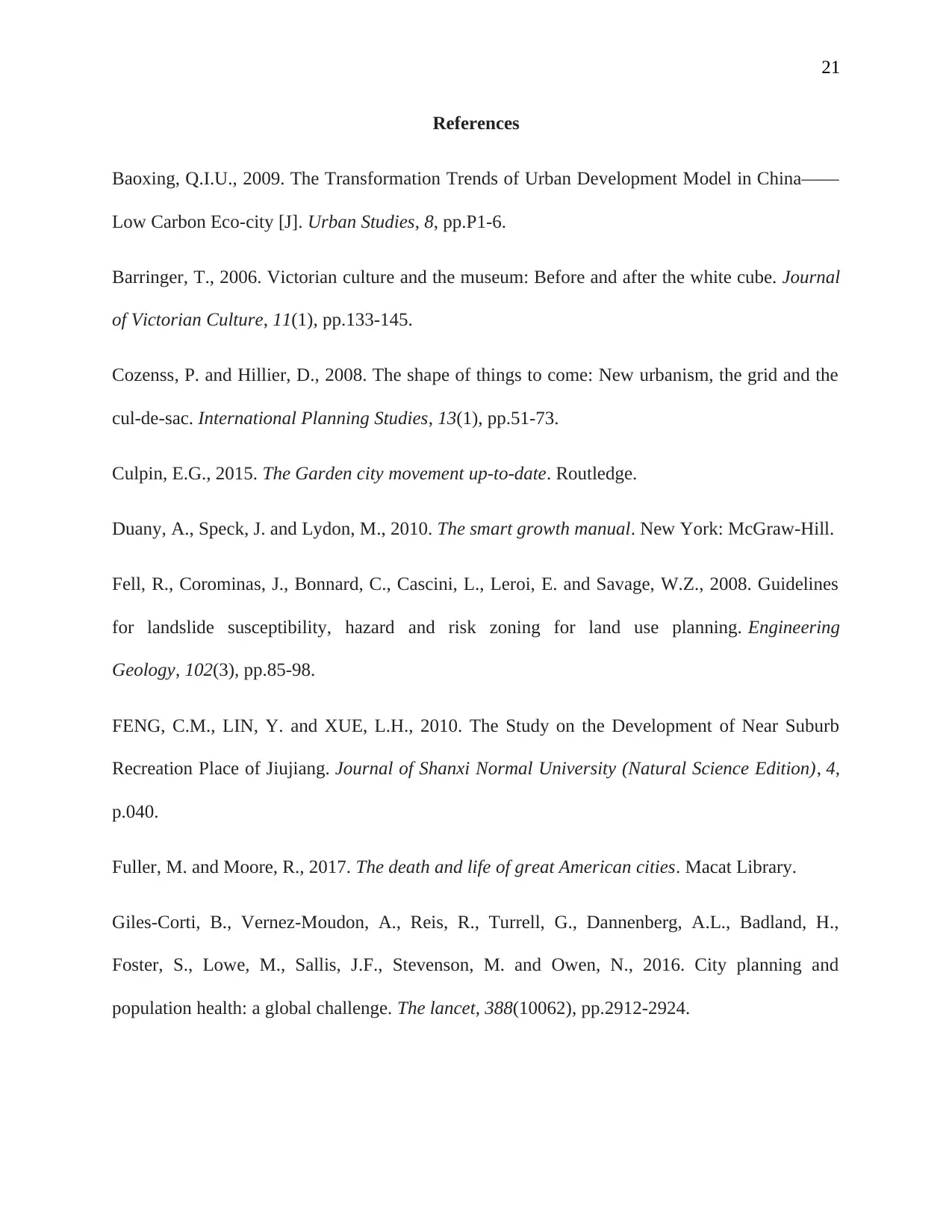
21
References
Baoxing, Q.I.U., 2009. The Transformation Trends of Urban Development Model in China——
Low Carbon Eco-city [J]. Urban Studies, 8, pp.P1-6.
Barringer, T., 2006. Victorian culture and the museum: Before and after the white cube. Journal
of Victorian Culture, 11(1), pp.133-145.
Cozenss, P. and Hillier, D., 2008. The shape of things to come: New urbanism, the grid and the
cul-de-sac. International Planning Studies, 13(1), pp.51-73.
Culpin, E.G., 2015. The Garden city movement up-to-date. Routledge.
Duany, A., Speck, J. and Lydon, M., 2010. The smart growth manual. New York: McGraw-Hill.
Fell, R., Corominas, J., Bonnard, C., Cascini, L., Leroi, E. and Savage, W.Z., 2008. Guidelines
for landslide susceptibility, hazard and risk zoning for land use planning. Engineering
Geology, 102(3), pp.85-98.
FENG, C.M., LIN, Y. and XUE, L.H., 2010. The Study on the Development of Near Suburb
Recreation Place of Jiujiang. Journal of Shanxi Normal University (Natural Science Edition), 4,
p.040.
Fuller, M. and Moore, R., 2017. The death and life of great American cities. Macat Library.
Giles-Corti, B., Vernez-Moudon, A., Reis, R., Turrell, G., Dannenberg, A.L., Badland, H.,
Foster, S., Lowe, M., Sallis, J.F., Stevenson, M. and Owen, N., 2016. City planning and
population health: a global challenge. The lancet, 388(10062), pp.2912-2924.
References
Baoxing, Q.I.U., 2009. The Transformation Trends of Urban Development Model in China——
Low Carbon Eco-city [J]. Urban Studies, 8, pp.P1-6.
Barringer, T., 2006. Victorian culture and the museum: Before and after the white cube. Journal
of Victorian Culture, 11(1), pp.133-145.
Cozenss, P. and Hillier, D., 2008. The shape of things to come: New urbanism, the grid and the
cul-de-sac. International Planning Studies, 13(1), pp.51-73.
Culpin, E.G., 2015. The Garden city movement up-to-date. Routledge.
Duany, A., Speck, J. and Lydon, M., 2010. The smart growth manual. New York: McGraw-Hill.
Fell, R., Corominas, J., Bonnard, C., Cascini, L., Leroi, E. and Savage, W.Z., 2008. Guidelines
for landslide susceptibility, hazard and risk zoning for land use planning. Engineering
Geology, 102(3), pp.85-98.
FENG, C.M., LIN, Y. and XUE, L.H., 2010. The Study on the Development of Near Suburb
Recreation Place of Jiujiang. Journal of Shanxi Normal University (Natural Science Edition), 4,
p.040.
Fuller, M. and Moore, R., 2017. The death and life of great American cities. Macat Library.
Giles-Corti, B., Vernez-Moudon, A., Reis, R., Turrell, G., Dannenberg, A.L., Badland, H.,
Foster, S., Lowe, M., Sallis, J.F., Stevenson, M. and Owen, N., 2016. City planning and
population health: a global challenge. The lancet, 388(10062), pp.2912-2924.
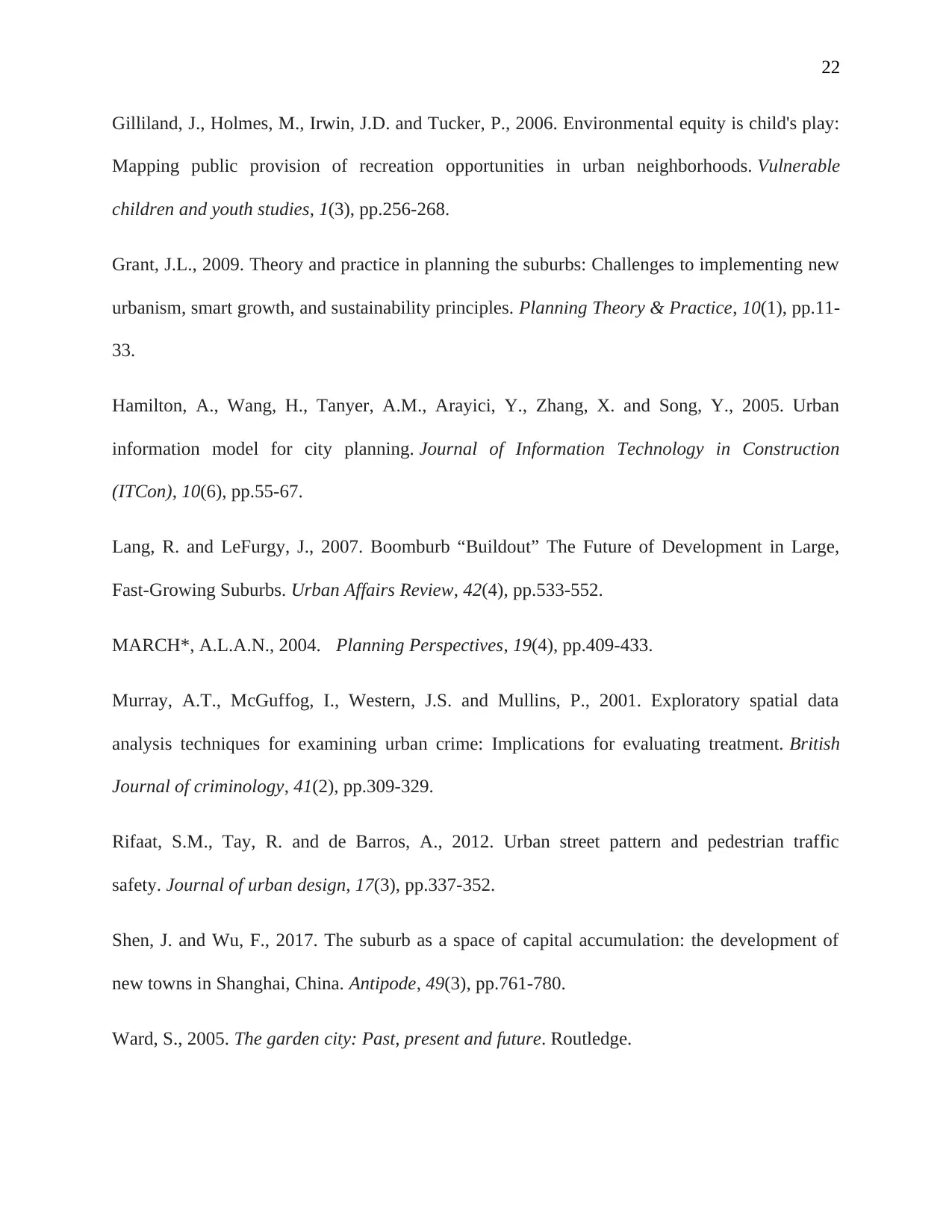
22
Gilliland, J., Holmes, M., Irwin, J.D. and Tucker, P., 2006. Environmental equity is child's play:
Mapping public provision of recreation opportunities in urban neighborhoods. Vulnerable
children and youth studies, 1(3), pp.256-268.
Grant, J.L., 2009. Theory and practice in planning the suburbs: Challenges to implementing new
urbanism, smart growth, and sustainability principles. Planning Theory & Practice, 10(1), pp.11-
33.
Hamilton, A., Wang, H., Tanyer, A.M., Arayici, Y., Zhang, X. and Song, Y., 2005. Urban
information model for city planning. Journal of Information Technology in Construction
(ITCon), 10(6), pp.55-67.
Lang, R. and LeFurgy, J., 2007. Boomburb “Buildout” The Future of Development in Large,
Fast-Growing Suburbs. Urban Affairs Review, 42(4), pp.533-552.
MARCH*, A.L.A.N., 2004. Planning Perspectives, 19(4), pp.409-433.
Murray, A.T., McGuffog, I., Western, J.S. and Mullins, P., 2001. Exploratory spatial data
analysis techniques for examining urban crime: Implications for evaluating treatment. British
Journal of criminology, 41(2), pp.309-329.
Rifaat, S.M., Tay, R. and de Barros, A., 2012. Urban street pattern and pedestrian traffic
safety. Journal of urban design, 17(3), pp.337-352.
Shen, J. and Wu, F., 2017. The suburb as a space of capital accumulation: the development of
new towns in Shanghai, China. Antipode, 49(3), pp.761-780.
Ward, S., 2005. The garden city: Past, present and future. Routledge.
Gilliland, J., Holmes, M., Irwin, J.D. and Tucker, P., 2006. Environmental equity is child's play:
Mapping public provision of recreation opportunities in urban neighborhoods. Vulnerable
children and youth studies, 1(3), pp.256-268.
Grant, J.L., 2009. Theory and practice in planning the suburbs: Challenges to implementing new
urbanism, smart growth, and sustainability principles. Planning Theory & Practice, 10(1), pp.11-
33.
Hamilton, A., Wang, H., Tanyer, A.M., Arayici, Y., Zhang, X. and Song, Y., 2005. Urban
information model for city planning. Journal of Information Technology in Construction
(ITCon), 10(6), pp.55-67.
Lang, R. and LeFurgy, J., 2007. Boomburb “Buildout” The Future of Development in Large,
Fast-Growing Suburbs. Urban Affairs Review, 42(4), pp.533-552.
MARCH*, A.L.A.N., 2004. Planning Perspectives, 19(4), pp.409-433.
Murray, A.T., McGuffog, I., Western, J.S. and Mullins, P., 2001. Exploratory spatial data
analysis techniques for examining urban crime: Implications for evaluating treatment. British
Journal of criminology, 41(2), pp.309-329.
Rifaat, S.M., Tay, R. and de Barros, A., 2012. Urban street pattern and pedestrian traffic
safety. Journal of urban design, 17(3), pp.337-352.
Shen, J. and Wu, F., 2017. The suburb as a space of capital accumulation: the development of
new towns in Shanghai, China. Antipode, 49(3), pp.761-780.
Ward, S., 2005. The garden city: Past, present and future. Routledge.
Secure Best Marks with AI Grader
Need help grading? Try our AI Grader for instant feedback on your assignments.
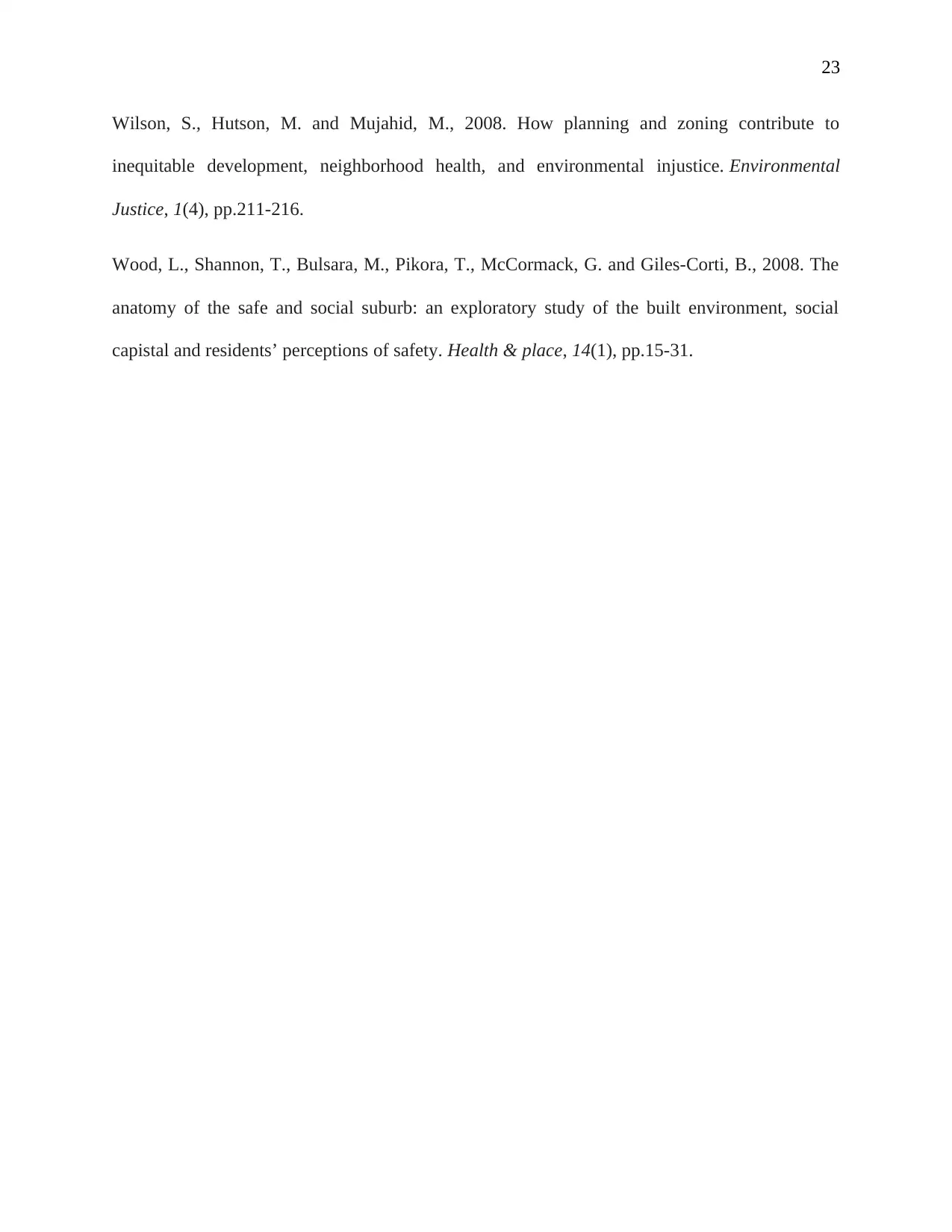
23
Wilson, S., Hutson, M. and Mujahid, M., 2008. How planning and zoning contribute to
inequitable development, neighborhood health, and environmental injustice. Environmental
Justice, 1(4), pp.211-216.
Wood, L., Shannon, T., Bulsara, M., Pikora, T., McCormack, G. and Giles-Corti, B., 2008. The
anatomy of the safe and social suburb: an exploratory study of the built environment, social
capistal and residents’ perceptions of safety. Health & place, 14(1), pp.15-31.
Wilson, S., Hutson, M. and Mujahid, M., 2008. How planning and zoning contribute to
inequitable development, neighborhood health, and environmental injustice. Environmental
Justice, 1(4), pp.211-216.
Wood, L., Shannon, T., Bulsara, M., Pikora, T., McCormack, G. and Giles-Corti, B., 2008. The
anatomy of the safe and social suburb: an exploratory study of the built environment, social
capistal and residents’ perceptions of safety. Health & place, 14(1), pp.15-31.
1 out of 23
Related Documents
Your All-in-One AI-Powered Toolkit for Academic Success.
+13062052269
info@desklib.com
Available 24*7 on WhatsApp / Email
![[object Object]](/_next/static/media/star-bottom.7253800d.svg)
Unlock your academic potential
© 2024 | Zucol Services PVT LTD | All rights reserved.





